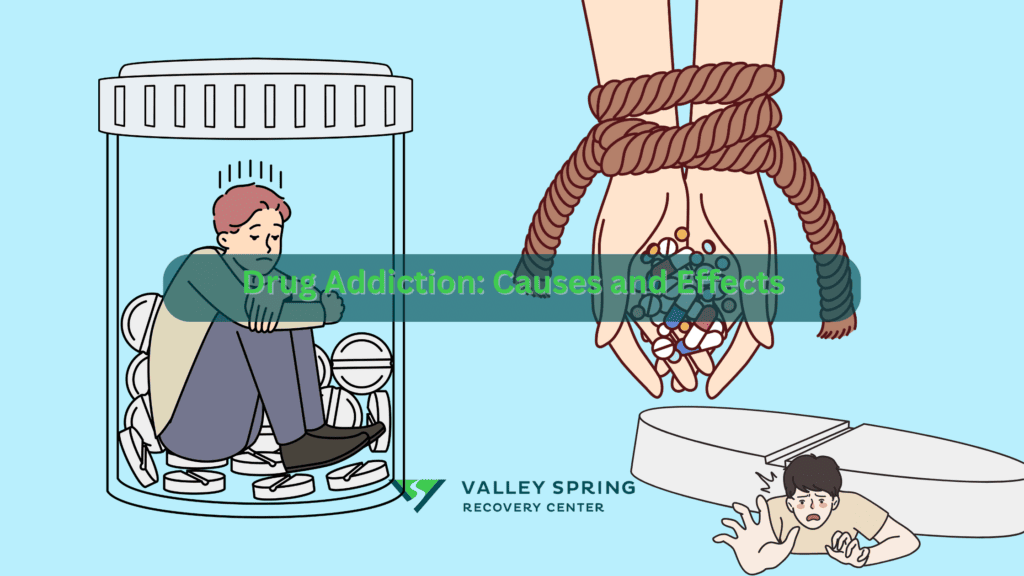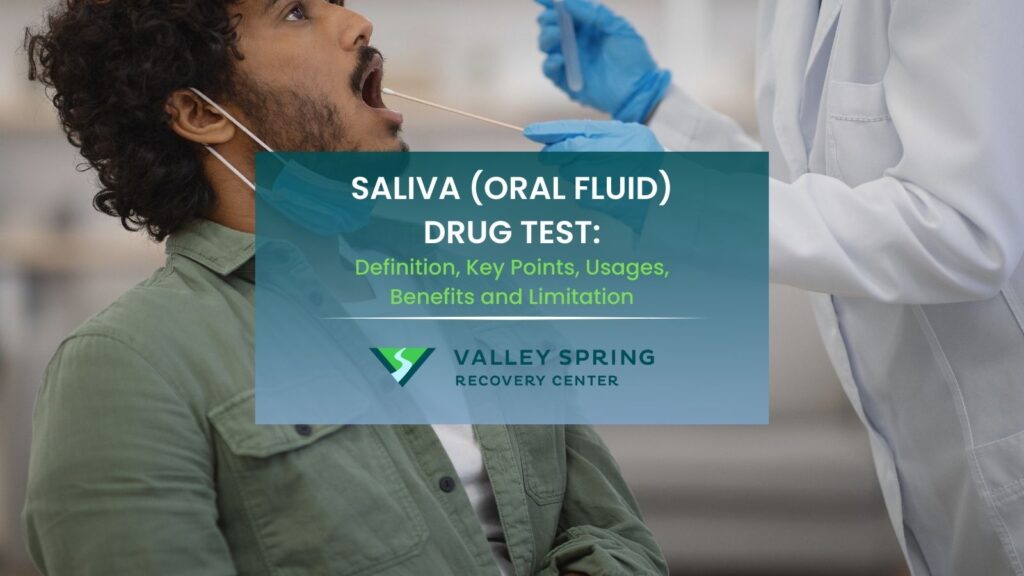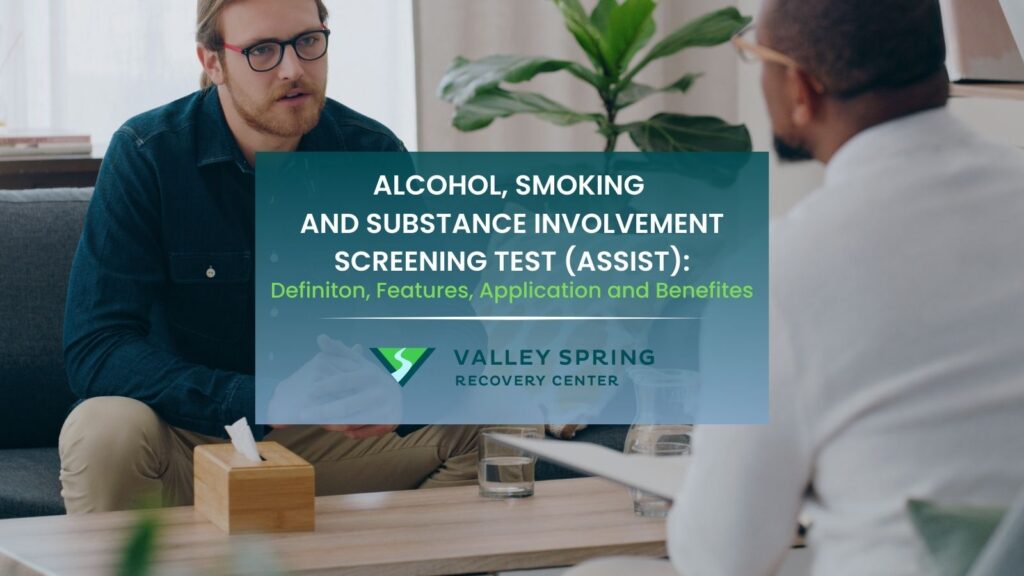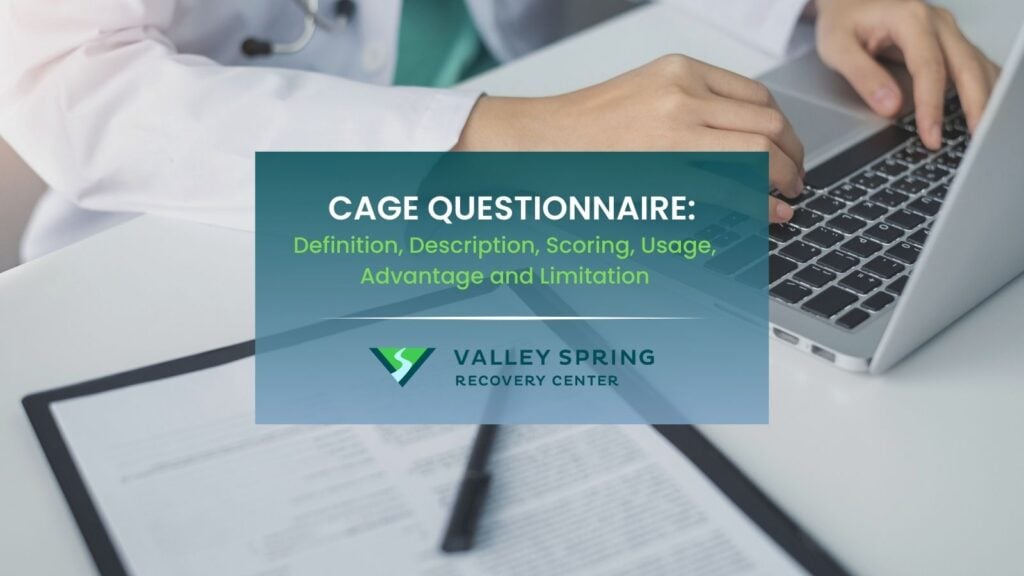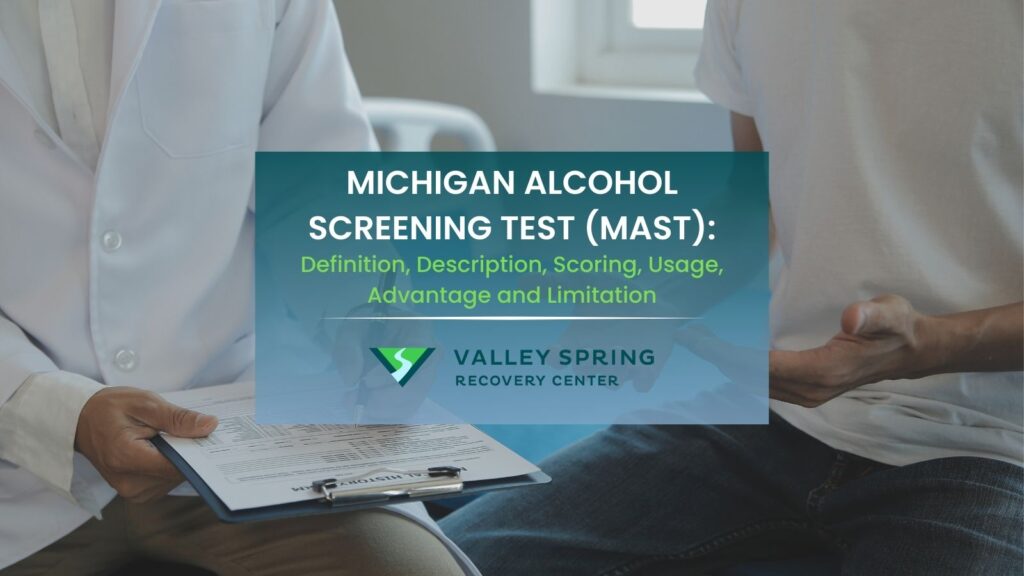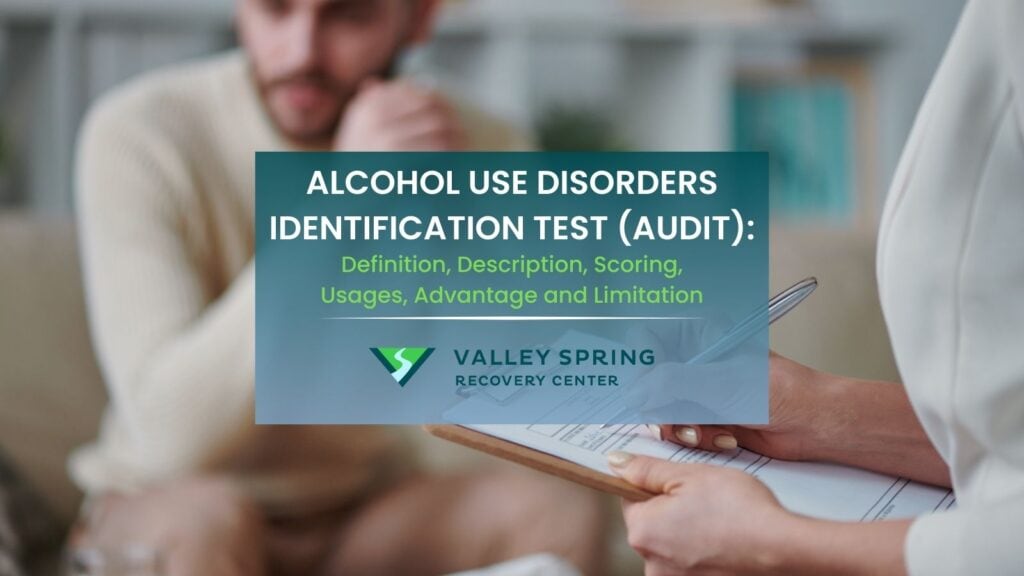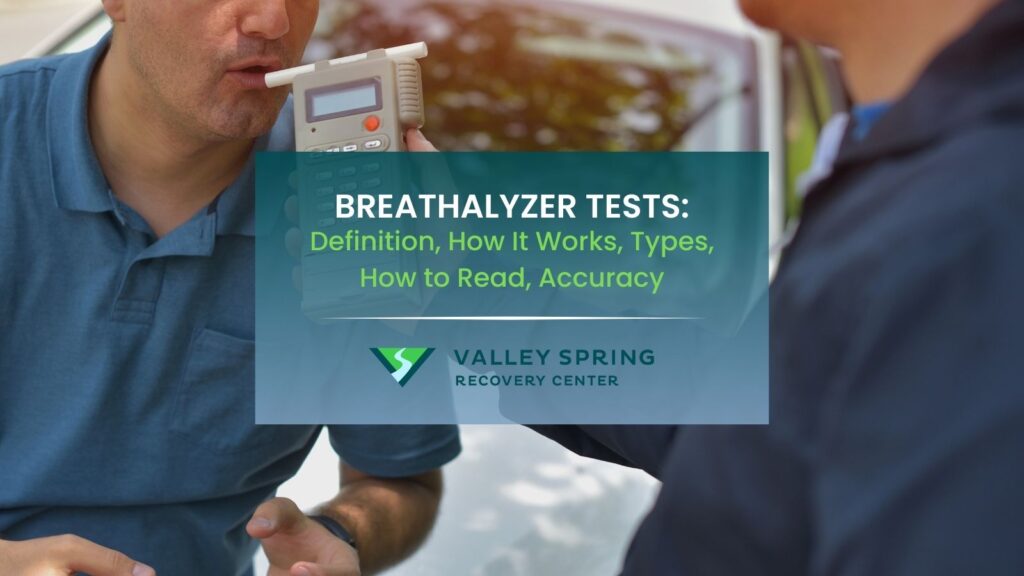Drug addiction, officially recognized as a substance use disorder, affects approximately 19.7% of adults in the United States according to 2023 data from the Substance Abuse and Mental Health Services Administration (SAMHSA). This condition is characterized by an uncontrollable urge to use drugs despite the significant harmful consequences it can lead to. The roots of addiction are diverse, influenced by genetic predispositions, environmental factors, and psychological conditions, making it a complex issue that transcends socioeconomic boundaries.
Individuals suffering from drug addiction experience a range of symptoms including persistent cravings, withdrawal symptoms, and a loss of control over drug use. The effects of abusing substances are profound, impacting physical health through conditions like liver damage, and mental health by increasing risks of disorders such as depression. Economically and socially, the repercussions are equally severe, affecting relationships and employment stability. Treatment typically involves a combination of detoxification, rehabilitation programs, and therapy, emphasizing the necessity for a supportive and comprehensive approach to facilitate effective recovery.

This article has been enhanced with input from the Medical Director and Addiction Psychiatrist at Valley Spring Recovery Center, Dr. Michael Olla.
Check the end of each section for extra information from him.
What Is Drug Addiction?
Drug addiction, clinically recognized as substance use disorder, is a chronic, relapsing brain condition that compels an individual to seek and use drugs despite adverse consequences. This disorder is characterized by significant alterations in the brain’s structure and function, which lead to compulsive behaviors, impaired judgment, and prioritization of drug use. Extensive research, including findings from the National Institute on Drug Abuse (NIDA) in their March 2022 report “Drugs and the Brain,” explains how addiction manipulates the brain’s reward system. It significantly increases dopamine levels—a neurotransmitter linked to pleasure and reward—reinforcing the behavior to use drugs and creating a difficult-to-break cycle of addiction.
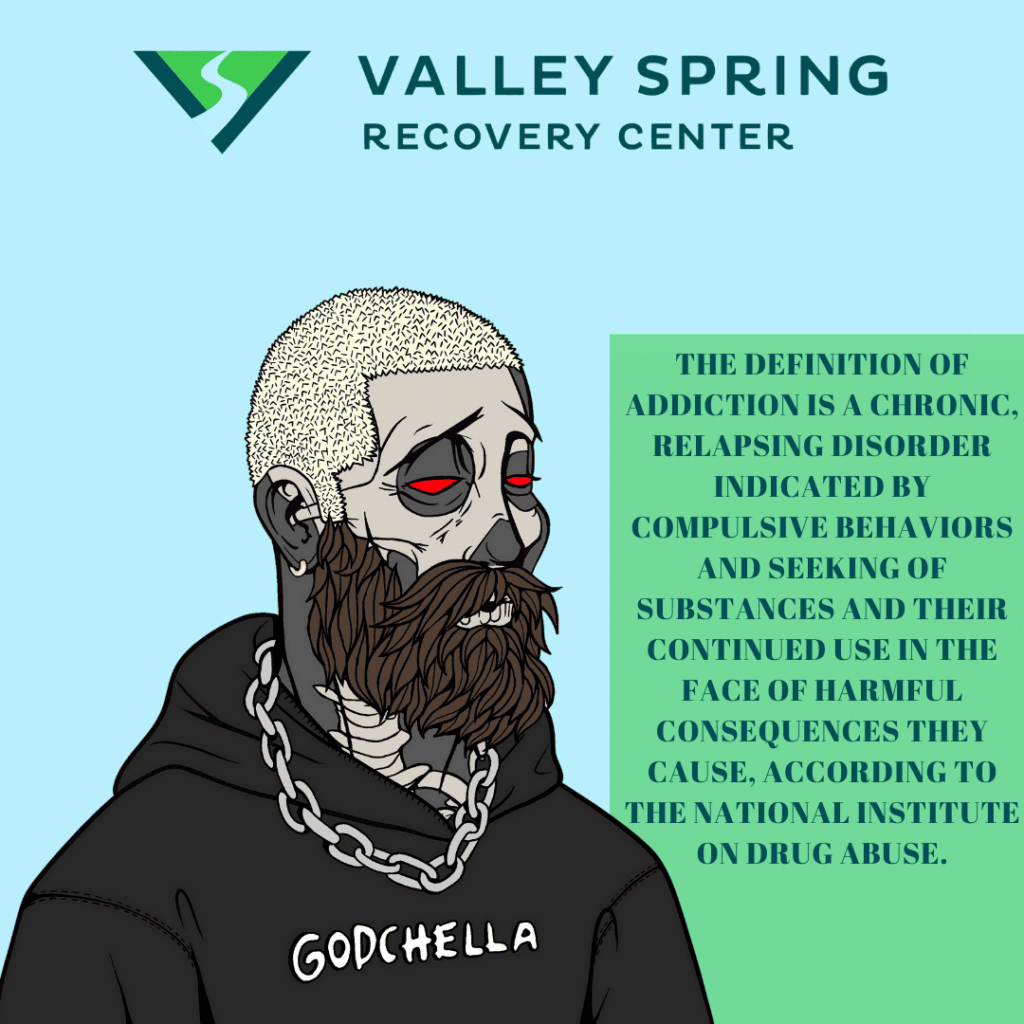
These profound brain changes affect various neural circuits, especially those related to reward, stress, and self-control. According to a study by Goldstein RZ and Volkow ND published in “Nature Reviews Neuroscience” in 2011, these changes can persist well beyond the cessation of drug use, impacting an individual’s ability to make decisions and regulate behaviors long-term.
The prevalence of drug addiction varies significantly across different regions in the United States, influenced by local factors such as the availability of substances and access to treatment facilities. For instance, the New Jersey Department of Health’s 2022 statistics reveal that approximately 8% of adults in the state suffer from a substance use disorder, illustrating the significant impact of this chronic condition at a local level.
Drug Abuse vs. Addiction
Drug abuse refers to the misuse of substances in a harmful way or outside social or medical norms, such as taking higher doses of a prescription than advised or using illicit drugs for their psychoactive effects. For instance, an individual might abuse prescription opioids by consuming larger amounts than prescribed, aiming to intensify the euphoric effect. This behavior increases the risk of physical harm and potential dependency, as highlighted in studies noting the misuse of opioids even under prescription, which often leads to more severe substance use disorders (Szalavitz, Rigg, & Wakeman, 2021).
Addiction, as defined in the Diagnostic and Statistical Manual of Mental Disorders, Fifth Edition (DSM-5), is a chronic, relapsing disorder marked by compulsive drug seeking and use, despite adverse consequences, and by long-lasting changes in the brain. It is classified under substance use disorders and involves alterations to brain circuits involved in reward, stress, and self-control, making it difficult to abstain without medical help (American Psychiatric Association, 2013). A typical example is nicotine addiction, where individuals continue smoking despite health issues like lung disease, driven by changes in the brain’s reward system that reinforce the behavior.
The relationship between drug abuse and addiction is that abuse can often precede addiction, serving as an initial phase where harmful effects begin to manifest but have not yet led to compulsive usage patterns. While drug abuse might involve sporadic use with potential negative consequences, addiction embodies a transition to chronic, dependent use compelled by brain adaptations. These adaptations include epigenetic changes and altered neurotransmission, which sustain cravings and compulsion, as detailed by Volkow and colleagues (2006) in their critique of the DSM’s previous editions’ conflation of dependence and addiction. This understanding underscores the critical differences between abuse and full-fledged addiction, where the latter involves a more profound physiological and psychological reliance that necessitates comprehensive treatment approaches.
Drug Dependence vs. Addiction
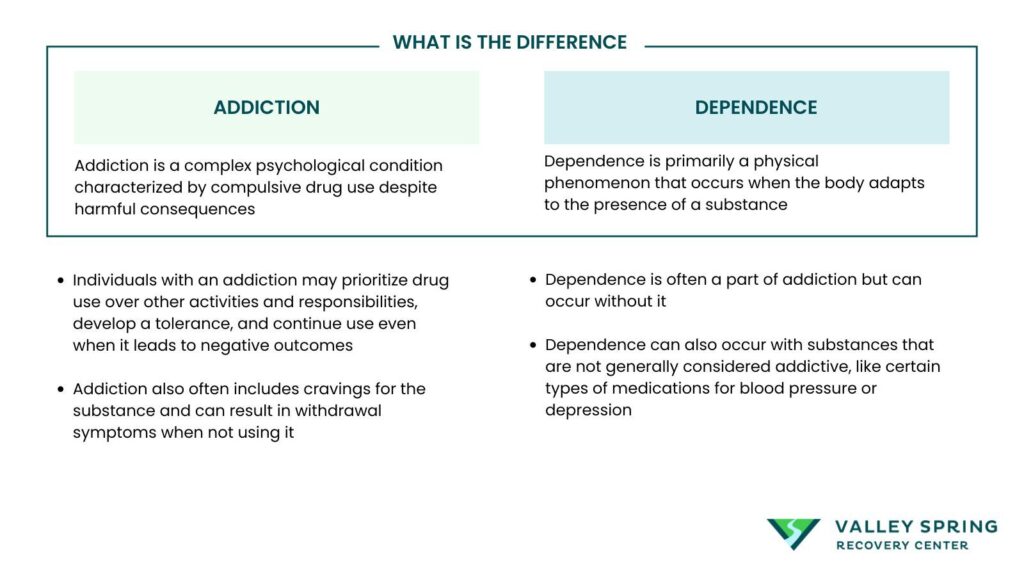
Drug dependence refers to the body’s physiological adaptation to sustained drug exposure, which manifests as tolerance and withdrawal symptoms when drug use is decreased or discontinued. This dependence is a natural outcome of long-term use of certain medications, including psychoactive drugs and other medications like beta-blockers and antidepressants. For example, patients on long-term beta-blocker therapy may experience withdrawal symptoms if the medication is abruptly stopped, indicating physiological dependence without the compulsive use associated with addiction (Szalavitz, Rigg, & Wakeman, 2021).
In contrast, addiction is characterized by compulsive drug seeking and use, despite harmful consequences. It involves significant changes in brain circuits related to reward, motivation, and memory, effects that may persist long after drug use ends. Addiction is fundamentally a brain disorder, marked by behavioral, physiological, and psychological symptoms, including a powerful craving for the drug and loss of control over its use (Volkow, 2011). The DSM-5 has updated its criteria to better distinguish between dependence and addiction, focusing on behavioral symptoms to enhance diagnostic accuracy and treatment efficacy (American Psychiatric Association, 2013).
Drug dependence describes the physical process of adapting to a drug, leading to tolerance and withdrawal symptoms which have minimal and manageable consequences. This is different from addiction, which includes a debilitating pattern of behavior that severely disrupts an individual’s life. It is crucial to distinguish between these conditions in clinical settings to prevent misdiagnosis and inappropriate treatment. Mislabeling patients with dependence as addicts can lead to unnecessary stigma and the discontinuation of essential medications, complicating their medical and psychological care. As emphasized by Szalavitz, Rigg, and Wakeman (2021), the outdated conflation of these terms in medical diagnoses, particularly in ICD codes, underscores the need for revised medical classifications that accurately reflect modern understanding of these distinct conditions.
Drug Tolerance vs. Dependence
Drug tolerance refers to the body’s diminished response to a drug, which results in needing higher doses to achieve the same effect. This reduction in effect is due to the body’s adaptive mechanisms that counteract the drug’s influence. Over time, this adaptation can affect various drug effects, including analgesia, sedation, or euphoria. For example, an individual prescribed opioids for pain management may initially find relief with lower doses; however, as tolerance develops, they may require higher doses to manage their pain effectively. This increase in dosage can elevate the risk of adverse effects and potential overdose (Lynch, S. S., 2022).
Drug dependence involves a more comprehensive physiological adaptation that includes but is not limited to tolerance. Substance dependence is marked by withdrawal symptoms that occur when drug use is abruptly reduced or ceased. These symptoms can be both physical, such as nausea and shakiness, and psychological, such as anxiety and cravings. An example of this is seen in individuals using benzodiazepines for anxiety relief; if they stop taking the medication suddenly, they may experience increased anxiety and physical withdrawal symptoms, indicating a dependence has developed.
While both tolerance and dependence involve physiological adaptations to drugs, they represent different aspects of the body’s response to sustained drug exposure. Tolerance alone does not necessarily lead to dependence but often occurs as part of the dependence process. A patient might develop tolerance to the sedative effects of a drug like zolpidem (used for insomnia), requiring larger doses to fall asleep. However, this does not imply dependence unless withdrawal symptoms are experienced upon discontinuation. In contrast, dependence on substances encompasses both tolerance and withdrawal, creating a more complex challenge in medical management and often requiring structured treatment and tapering plans to safely discontinue drug use. This nuanced understanding is critical to avoid misdiagnosis and ensure appropriate treatment, as highlighted by Szalavitz, Rigg, and Wakeman in their 2021 study titled “Drug dependence is not addiction—and it matters,” stressing the importance of distinguishing these conditions to improve patient outcomes and reduce unnecessary medical and social complications associated with mislabeling.
Drug Addiction vs. Alcoholism
Drug addiction is a complex disorder characterized by compulsive drug seeking and use despite harmful consequences. It involves significant changes in brain circuits involved in reward, stress, and self-control. These changes can persist long after the cessation of drug use, making recovery challenging. Drug addiction can encompass a variety of substances, each affecting the brain differently. For example, cocaine stimulates the central nervous system, creating a quick, intense euphoria, leading to severe psychological dependence and intense withdrawal symptoms without physical markers (National Institute on Drug Abuse, 2022).
Alcoholism, officially known as Alcohol Use Disorder (AUD), is similarly marked by an inability to control alcohol use regardless of adverse health, social, or occupational consequences. It can range from mild to severe, often requiring professional intervention for recovery. AUD is particularly insidious due to alcohol’s legal status and social acceptance, which can delay the recognition of a problem and intervention. Chronic alcohol use leads to changes in the same brain regions as other drugs but includes unique risks like liver disease and increased cancer risk according to the National Institute on Alcohol Abuse and Alcoholism’s 2021 fact sheet on Understanding Alcohol Use Disorder.
While both drug addiction and alcoholism involve the neurobiological alteration of the brain’s reward system, their societal views and implications differ greatly. Alcohol is legal and widely consumed in social settings, often minimizing the perceived risk until severe consequences manifest. In contrast, many drugs associated with addiction (like heroin and methamphetamine) are illegal and heavily stigmatized. This distinction affects public perception, policy, and treatment approaches. Moreover, withdrawal from alcohol can be life-threatening, requiring medical supervision, unlike many drugs where withdrawal, while extremely uncomfortable, is less likely to be fatal. Treatment approaches thus vary; alcohol use disorder withdrawal symptoms require pharmacological management to ensure safety, reflecting these critical differences as highlighted in the 2022, Cycle of Alcohol Addiction report published by The National Institute on Alcohol Abuse and Alcoholism, NIAAA.
Behavioral Addictions Vs Drug Addictions
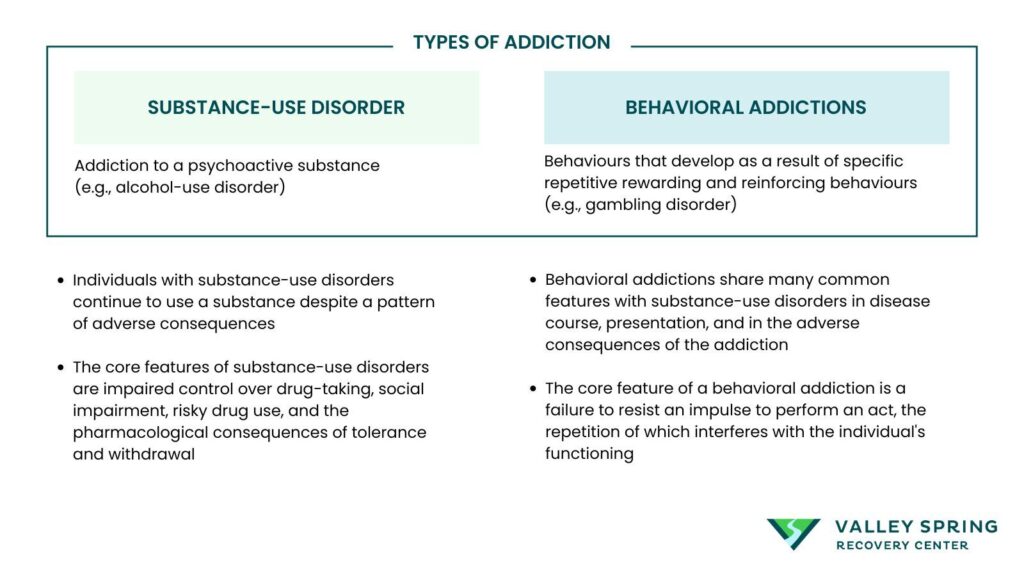
Behavioral addiction refers to a compulsion to engage in activities that trigger the brain’s reward systems without involving substance consumption. Common examples include gambling, internet addiction, shopping, and excessive video gaming. For instance, gambling addiction involves repetitive behavior despite adverse consequences, driven by the desire to experience the thrill and potential reward of winning. These activities produce similar neurological responses to those induced by drugs, such as increased dopamine levels, which reinforce the behavior (Alavi, Seyyed Salman et al., 2012).
Drug addiction is characterized by the compulsive use of substances that chemically alter brain function and structure. These substances, including alcohol, nicotine, opioids, and stimulants, directly impact the brain’s reward system, elevating dopamine levels and causing changes in areas related to reward, stress, and self-control. An example is heroin addiction, where users experience a rush of euphoria shortly after use, leading to strong physical dependency and severe withdrawal symptoms when not using the drug.
The primary difference between behavioral and drug addictions lies in the nature of the addictive agent. Behavioral addictions do not involve chemical substances but can still lead to significant psychological and social consequences similar to drug addictions. While drug addictions are often associated with direct, observable physical health effects and may require detoxification and medication-assisted treatment, behavioral addictions involve interventions that focus more on psychological support and behavior modification strategies.
Both types of addictions activate similar neurological pathways related to reward and compulsion, but the treatment and management of these disorders can differ significantly due to the presence or absence of physical withdrawal symptoms and the societal perception of the addictive behaviors. Nonetheless, both require comprehensive and tailored treatment approaches to address the complex nature of addiction and ensure effective recovery and management of the disorder.
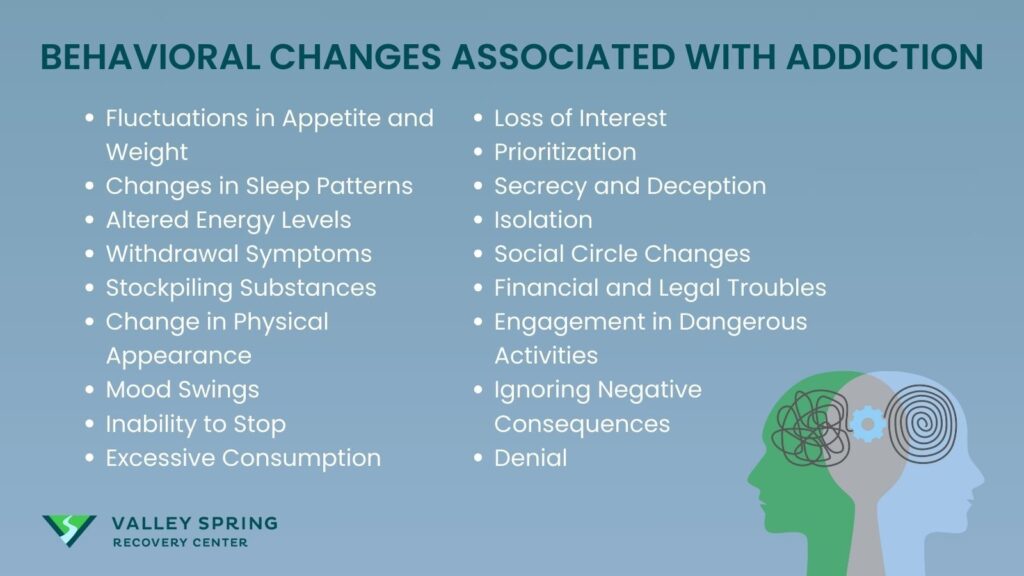
What Are the Signs and Symptoms of Substance Use Disorder?
The identification of drug addiction relies heavily on observing a range of behavioral, physical, and psychological symptoms. These symptoms, as delineated by the Diagnostic and Statistical Manual of Mental Disorders, Fifth Edition (DSM-5), help clinicians and caregivers recognize and diagnose substance use disorders.
The most common signs of drug addiction are listed below.
- Persistent Use and Increased Tolerance: One of the most obvious signs of addiction is the need to consume increasingly larger amounts of the substance to achieve the same effects once felt at lower doses. For instance, an individual might start by taking a small dose of opioids for pain but gradually needs to increase the dose to achieve the same pain relief or euphoria (DSM-5).
- Withdrawal Symptoms: As the body becomes accustomed to the substance, discontinuation leads to physical and psychological withdrawal symptoms, such as nausea, shaking, anxiety, and irritability. This is particularly common with alcohol and benzodiazepines, where withdrawal can be severe and, in some cases, life-threatening. Withdrawal can manifest as both physical and psychological symptoms. Physical symptoms might include headaches, muscle pain, and sweating, while psychological symptoms could encompass anxiety, depression, and insomnia. Withdrawal indicates physical dependence and can often be a driving factor behind continued use due to the discomfort and difficulty associated with stopping.
- Loss of Control Over Use: Despite intentions to control or reduce their usage, individuals often find themselves unable to do so. An example of loss of control is highlighted by Dr Michael Olla who states “spending excessive time acquiring the substance of choice, using it, and recovering from its effects without regard for other responsibilities is a clear sign of addiction.”
- Craving: Cravings are powerful, intense urges to use a substance and are a psychological hallmark of addiction. The desire or urge to use the substance becomes powerful and overpowers other thoughts and responsibilities. These can be triggered by exposure to drug-related cues, stress, or emotional distress, often leading to relapse.
- Failure to Fulfill Obligations: Substance addiction often leads to a neglect of responsibilities at work, home, or school, significantly impairing daily functioning and relationships.
- Continued Use Despite Problems: Individuals persist in using the substance even when it causes or exacerbates social or interpersonal problems.
- Social Withdrawal: As addiction deepens, individuals may abandon hobbies, social activities, and occupational responsibilities that were once important to them, further isolating themselves.
- Hazardous Use: Engaging in risky behaviors, such as driving under the influence or operating machinery while impaired, indicates a disregard for safety directly related to substance use.
- Continued Use Despite Health Issues: Individuals may continue using substances despite clear evidence of physical or psychological harm caused or worsened by their use.
- Changes in Appearance: Noticeable neglect in personal grooming and general physical decline are often signs of chronic substance use.
- Altered Energy Levels: Users may experience bursts of hyperactivity or, conversely, periods of extreme fatigue, depending on the substance used.
- Mood Swings: Extreme and sudden changes in mood, ranging from euphoria to intense irritability or sadness, can be indicative of substance use and withdrawal cycles.
- Denial: Individuals frequently underestimate the extent of their substance use or its impact, rationalizing or minimizing the severity to others and themselves.
- Secrecy and Deception: To hide their addiction, individuals might lie about their whereabouts, activities, and substance use, potentially leading to further social isolation and trust issues within personal relationships.
- Financial and Legal Troubles: Excessive spending on substances, debt accumulation, or legal issues related to substance use, such as arrests for DUI, are critical red flags.
- Engagement in Dangerous Activities: Addiction can lead to engagement in increasingly risky activities, necessary to obtain the substance or as part of its use.
- Ignoring Negative Consequences: Persisting in substance use despite obvious detrimental effects on health, relationships, and overall well-being underscores the compulsive nature of addiction.
Understanding these nuanced symptoms is vital for early detection and intervention, potentially leading to more effective treatment outcomes. Recognizing the full spectrum of addiction signs—behavioral, physical, and psychological—is crucial for providing comprehensive care and support to individuals struggling with addiction. The DSM-5 specifies that the presence of at least two of these symptoms within a 12-month period may indicate a substance use disorder. The severity of the disorder is gauged by the number of criteria met: mild (2-3 criteria), moderate (4-5 criteria), and severe (6 or more criteria). This framework helps in recognizing the depth and extent of an addiction, guiding healthcare professionals toward the most appropriate treatment and support strategies. By understanding the warning signs of addiction help caregivers and individuals affected can better navigate the complexities of addiction and recovery paths.
What Are The Causes Of Addiction?
The causes of drug addiction encompass biological determinants, environmental catalysts, psychological and emotional triggers, and developmental and behavioral factors, highlighting the complex interplay of genetics, upbringing, mental health, and early substance exposure according to the 2024 NIDA report titled “Drug Misuse and Addiction”.
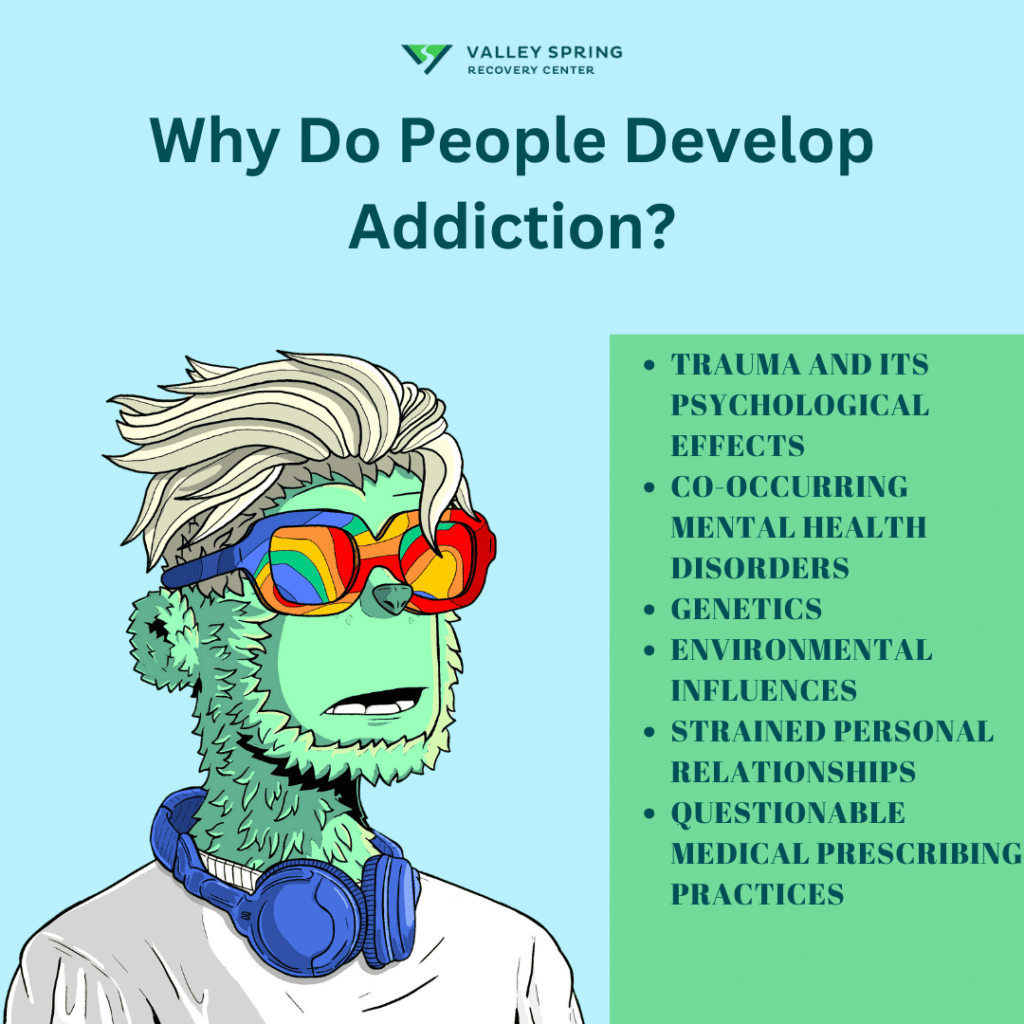
- Biological Determinants: Genetic factors significantly influence an individual’s predisposition to substance dependency. A combination of genetic variables directly impacts vulnerability to addiction. Moreover, neurodevelopmental factors, notably the ongoing development of the prefrontal cortex in adolescents, heighten the risk of substance dependency, especially with early substance exposure.
- Environmental Catalysts: The environment plays a crucial role in determining the likelihood of addiction. Peer groups that promote substance misuse often encourage similar behaviors in others. A family history of substance abuse intensifies this risk. Additionally, socioeconomic barriers, such as limited access to education and healthcare, increase susceptibility to addiction. These environmental influences are pivotal during critical developmental stages, shaping an individual’s addiction risk.
- Psychological and Emotional Triggers: Continuous stress and negative life events are significant psychological triggers for substance dependency. Disorders like Post-Traumatic Stress Disorder (PTSD), depression, and anxiety frequently accompany addiction, necessitating a dual-diagnosis approach for effective treatment. Peer pressure, along with physical and sexual abuse, early drug exposure, stress, and the role of parental guidance, profoundly influences an individual’s risk of substance use and addiction.
- Developmental and Behavioral Factors: Early initiation of substance use markedly increases the risk of developing a long-term dependency. Certain personality traits or disorders predispose individuals to addiction. A comprehensive understanding of these diverse risk factors offers a holistic perspective on susceptibility to addiction, highlighting the complex interaction between biological, environmental, and psychological factors.
Genetics predispose individuals to addiction, but environmental factors like stress, societal pressures, and accessibility often act as triggers. It’s generally a complex interplay between the two.
What Are The Effects of Addiction?
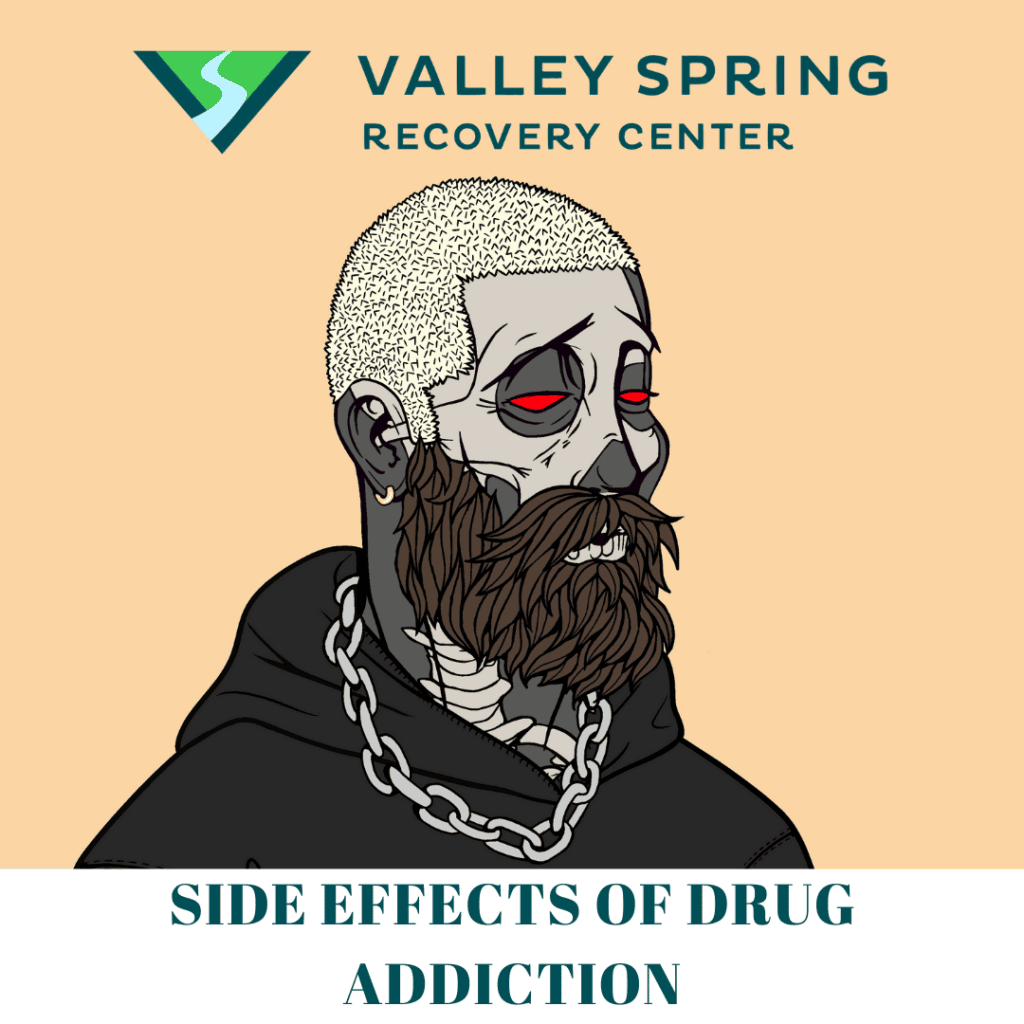
The effects and consequences of drug addiction are far-reaching and profoundly impact nearly every part of an individual’s life, affecting their physical health, emotional well-being, relationships, and even their standing in society.
- Physical Health: One of the most immediate effects of drug addiction is physical health. Depending on the substance abused, individuals experience a range of health issues including liver damage, respiratory problems, cardiovascular diseases, stroke, cancer, and infectious diseases like HIV/AIDS from shared injection equipment.
- Mental Health: Drug addiction often co-occurs with a range of mental health issues, such as depression, anxiety, and schizophrenia. Substance abuse exacerbates mental health conditions, creating a vicious cycle that’s difficult to break.
- Relationships: Addiction strains relationships with loved ones due to erratic or violent behavior, neglect of responsibilities, and other negative consequences of drug use. This often leads to isolation from family and friends, creating a further emotional toll.
- Economic Impact: The financial burden of sustaining a drug habit leads to job loss and homelessness. The cost of purchasing the drug, coupled with reduced productivity and increased healthcare expenses, causes financial strain.
- Legal Consequences: Drug addiction leads to a host of legal problems, including arrest, incarceration, and a lifelong criminal record, which in turn affects employment prospects and social standing.
- Social Stigma: The societal perception of drug addicts is often negative, which leads to stigmatization and further isolation. This social stigmas make it more difficult for individuals to seek help and often exacerbates the emotional toll of addiction.
- Overall Quality of Life: Ultimately, drug addiction significantly lowers the users quality of life, leading to a loss of interest in activities that once brought joy, and many times leads to overdose and premature death.
The effects of drug addiction severely impacts every aspect of an individual’s life, causing extensive physical health issues, exacerbating mental health conditions, and straining personal relationships. The economic and legal repercussions add further challenges, while societal stigma can discourage seeking necessary help. These combined effects drastically reduce quality of life, trapping individuals in a debilitating cycle of addiction that is difficult to escape without holistic treatment and strong support networks. Recognizing the multifaceted impact of addiction is essential for effective intervention and recovery.
What Are The Stages Of Addiction?
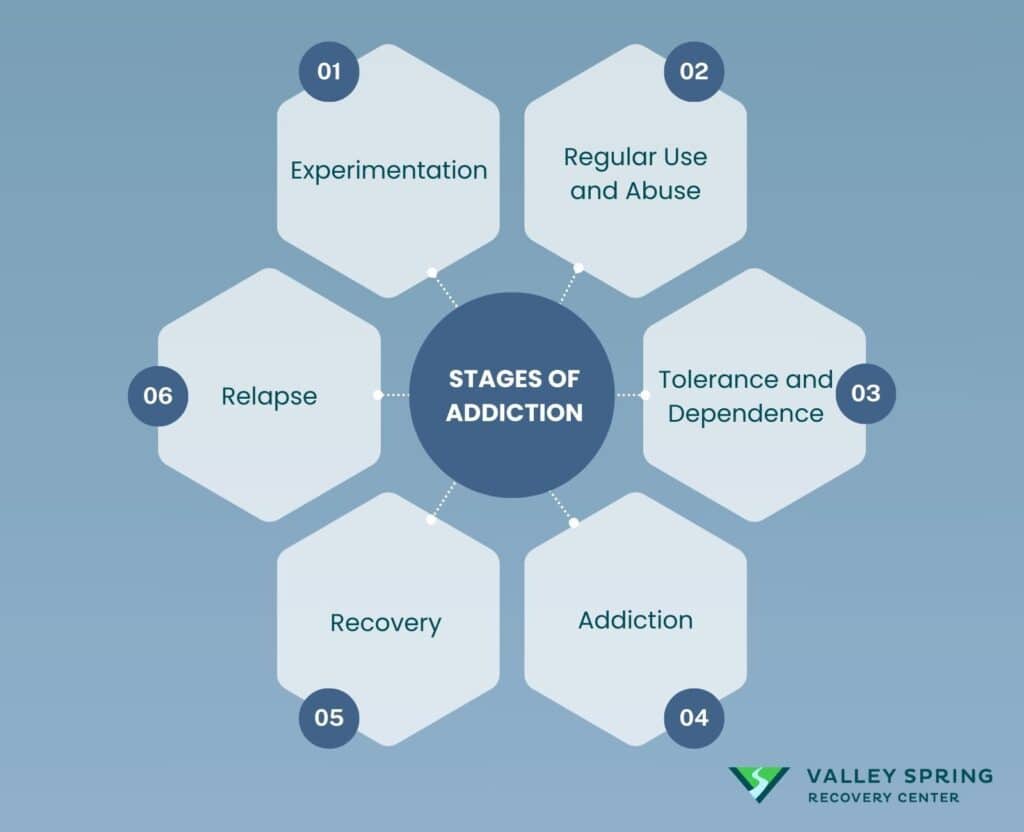
Addiction progresses through stages from initial experimentation due to curiosity or peer pressure, to regular use and abuse, developing tolerance and dependence, reaching compulsive addiction, moving through recovery efforts, and sometimes experiencing relapse, with each stage requiring tailored intervention strategies.
- Experimentation: Experimentation is typically the first stage of addiction, where individuals use substances occasionally out of curiosity, peer pressure, or to seek pleasure. During this phase, use is infrequent and, in some cases, may not progress any further. The National Institute on Drug Abuse (NIDA, 2020) notes that genetic factors can significantly affect whether an individual moves beyond this stage.
- Regular Use and Abuse: As use becomes more frequent, the transition from experimentation to regular use and then to abuse can occur. This stage is characterized by the increasing priority given to substance use over other activities, despite the awareness of adverse consequences. For some, substance use becomes a key method for coping with problems or emotions, escalating the risk of progressing to more severe stages.
- Tolerance and Dependence: Continuous and increased substance use leads to tolerance, where the body requires higher doses of the substance to achieve the initial effects. Dependence can be psychological or physical, indicating that the body has adapted to the substance’s presence. Withdrawal symptoms will appear if substance use is reduced or stopped, signaling physical dependence.
- Addiction: Addiction is marked by the inability to stop using the substance despite harmful physical, psychological, and social consequences. At this stage, the use is compulsive and out of control. Addiction impacts various aspects of an individual’s life, including relationships, work, and health.
- Recovery: Recovery involves actively engaging in addiction treatment and recovery activities to overcome addiction. This can include therapy, medication-assisted treatment, and support groups. Recovery is an ongoing process and often requires lifelong commitment and support to maintain sobriety.
- Relapse: Relapse is not uncommon and should be considered a part of the process rather than a failure. It occurs when an individual returns to substance use after a period of abstinence and often highlights the need for continued or adjusted treatment strategies.
Understanding the stages of addiction is crucial for recognizing the signs of addiction and intervening effectively. Each stage may require different treatment approaches, emphasizing the need for personalized care tailored to the individual’s specific situation. According to NIDA (2020), effective addiction treatment must address all aspects of addiction, not just substance use, to improve recovery outcomes and reduce the likelihood of relapse.
What Are The Most Common Types of Drug Addiction?
Drug addiction is a global issue affecting millions, with various substances, from legal prescriptions to illicit drugs, being widely abused. This abuse leads to severe health, social, and economic consequences. The most commonly abused substances include opioids (like oxycodone, hydrocodone, and heroin), cocaine, methamphetamine, cannabis (marijuana), alcohol, and benzodiazepines (such as Valium and Xanax). These drugs are prevalent due to their availability, potency, and the euphoric effects they induce, making them highly addictive and, in some cases, expensive.
Drugs are addictive because they manipulate the brain’s reward system, releasing large amounts of dopamine, a neurotransmitter linked to pleasure and reinforcement. This dopamine surge creates a strong association between the drug and the pleasurable experience, driving individuals to repeatedly seek out the drug to achieve the same effect. Over time, this alters the brain’s natural dopamine production, making it difficult to experience pleasure from everyday activities and leading to a cycle of compulsive drug use despite negative consequences, a core feature of addiction.
Alcohol Use Disorder (AUD)
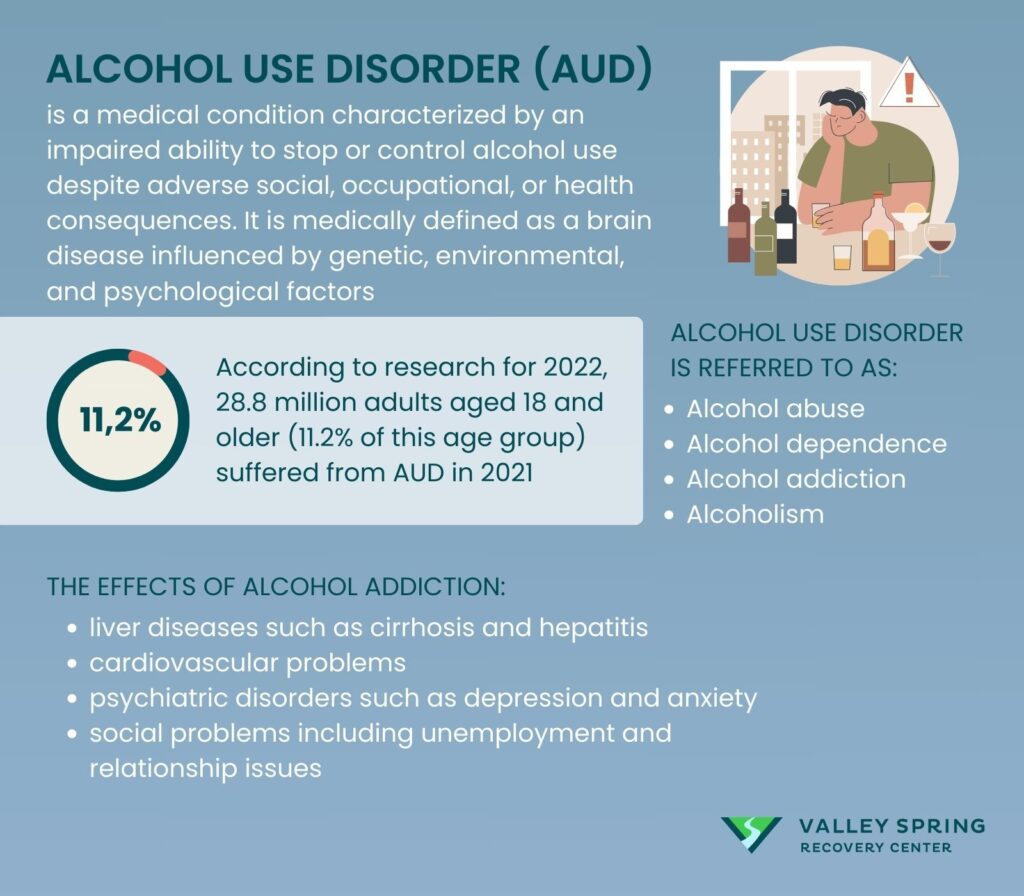
Alcohol use disorder (AUD) is a medical condition characterized by an impaired ability to stop or control alcohol use despite adverse social, occupational, or health consequences. It is medically defined as a brain disease influenced by genetic, environmental, and psychological factors that can be mild, moderate, or severe according to a 2020 report on Alcohol’s effects on health by the National Institute of Alcohol Abuse and Alcoholism (NIAAA). Alcohol Use Disorder is referred to as alcohol abuse, alcohol dependence, alcohol addiction, and alcoholism.
According to the 2022 National Survey on Drug Use and Health and the Center for Behavioral Health Statistics and Quality’s 2022 study, 28.8 million adults aged 18 and older (11.2% of this age group) suffered from AUD in 2021. An estimated 753,000 adolescents ages 12 to 17 (2.9% of this age group) had AUD during this time frame.
The effects of Alcohol Use Disorder (AUD) can lead to devastating long-term health consequences including liver diseases such as cirrhosis and hepatitis, cardiovascular problems, psychiatric disorders such as depression and anxiety, and social problems including unemployment and relationship issues. The World Health Organization 2022 fact sheet on alcohol reveals Alcohol Use Disorder is the world’s third-largest risk factor for disease and mortality, responsible for an estimated 3 million deaths globally each year, representing 5.3% of all deaths.
According to Dr Michael Olla, an addiction psychiatrist, treatment for alcohol use disorder includes a combination of therapies, medication, and support groups. Detoxification under medical supervision is often the first step, followed by behavioral therapies like cognitive-behavioral therapy (CBT) and motivational enhancement therapy (MET). Medications such as naltrexone, acamprosate, and disulfiram are also used to help reduce drinking and prevent relapse. Support from organizations such as Alcoholics Anonymous (AA) offers a community-based approach to recovery, emphasizing peer support and accountability.
Tobacco and Nicotine Addiction
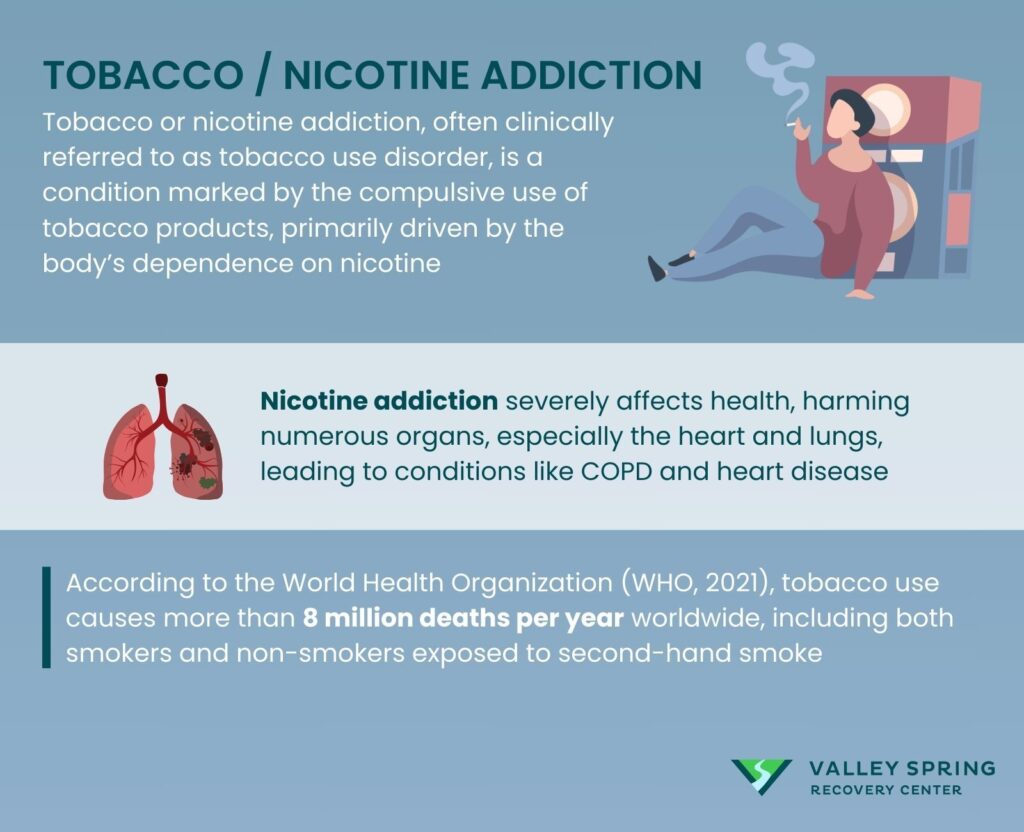
Tobacco or nicotine addiction, often clinically referred to as tobacco use disorder, is a condition marked by the compulsive use of tobacco products, primarily driven by the body’s dependence on nicotine. This chemical is highly addictive, affecting the same brain pathways as heroin and cocaine. The Centers for Disease Control and Prevention (CDC) 2020 report highlights that nicotine addiction is the most prevalent form of chemical dependence in the United States. It alters brain chemistry, making quitting smoking exceptionally challenging.
The health impacts of nicotine addiction are severe and widespread, affecting nearly every organ in the body. It is particularly detrimental to the cardiovascular and respiratory systems, leading to diseases such as chronic obstructive pulmonary disease (COPD) and heart disease. According to the World Health Organization (WHO, 2021), tobacco use causes more than 8 million deaths per year worldwide, including both smokers and non-smokers exposed to second-hand smoke. Cigarette smoking alone kills more than 480,000 Americans each year according to the U.S. Department of Health and Human Services Office on Smoking and Health 2014 research.
Addressing nicotine addiction requires a multi-pronged treatment approach that includes Nicotine Replacement Therapy (NRT) products like gums, patches, and lozenges are commonly used to mitigate withdrawal symptoms and decrease the urge to smoke. Non-nicotine medications such as bupropion and varenicline have also been effective in helping individuals quit by targeting the brain’s nicotine receptors. Furthermore, behavioral therapies and support groups provide the psychological support needed to overcome addiction to tobacco and nicotine. The American Lung Association 2023 Tobacco Cessation article emphasizes combining these treatments to increase the chances of successfully quitting and was reaffirmed by the U.S. Surgeon General’s Report on Smoking Cessation, released January 23.
Opioid Addiction
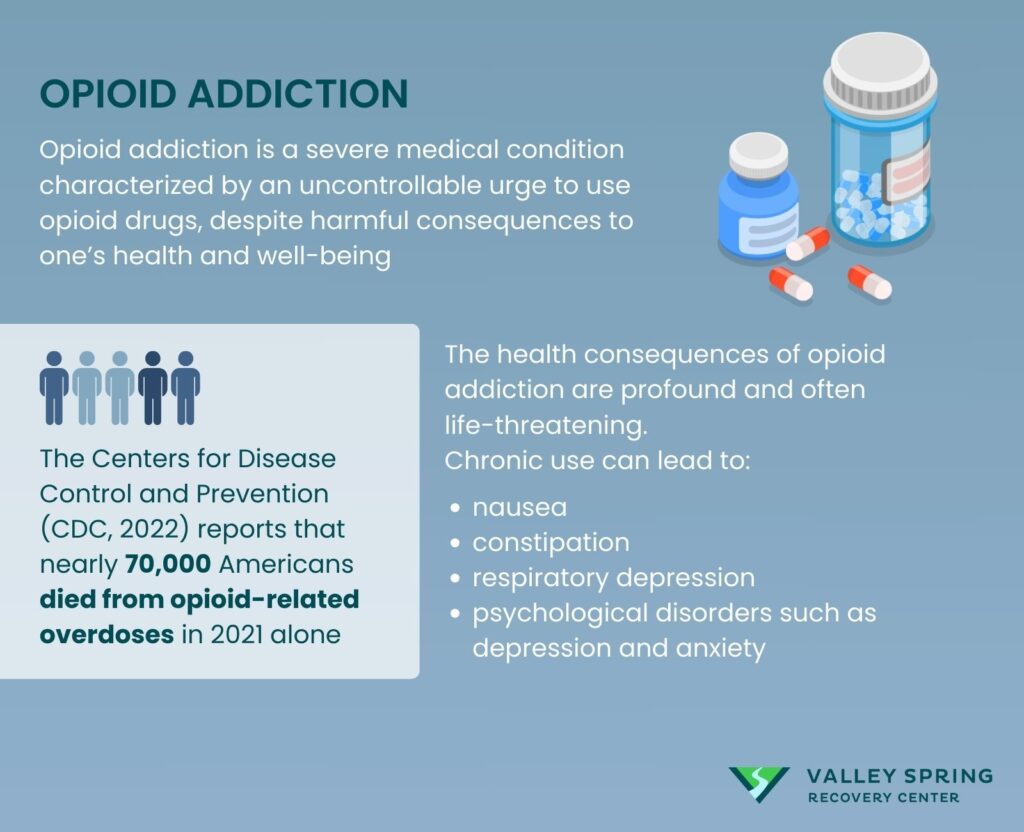
Opioid addiction is a severe medical condition characterized by an uncontrollable urge to use opioid drugs, despite harmful consequences to one’s health and well-being. Opioids, which include both illegal drugs like heroin and prescription pain relievers such as oxycodone and morphine, act on the nervous system to produce pain-relieving and euphoric effects. According to the National Institute on Drug Abuse (NIDA, 2020), opioid addiction can disrupt significant aspects of life, leading to physical and psychological dependence that requires more than willpower to overcome.
The opioid epidemic has become a public health crisis, especially in the United States. The Centers for Disease Control and Prevention (CDC, 2022) reports that nearly 70,000 Americans died from opioid-related overdoses in 2021 alone. This statistic highlights the urgent need for effective intervention strategies and broader public awareness about the dangers of opioid misuse.
The health consequences of opioid addiction are profound and often life-threatening. Chronic use can lead to nausea, constipation, respiratory depression, and psychological disorders such as depression and anxiety. Long-term use also increases the risk of infectious diseases like HIV and hepatitis due to needle sharing. The World Health Organization (WHO, 2022) emphasizes that opioid addiction not only affects the individual’s health but also has significant social and economic impacts, contributing to increased healthcare costs and productivity losses.
Treatment for opioid addiction is comprehensive and often includes both medications and behavioral counseling. Medication-assisted treatment (MAT) is considered the gold standard, using medications such as methadone, buprenorphine, and naltrexone to reduce withdrawal symptoms and cravings. These treatments are most effective when combined with behavioral therapies that address the underlying causes of addiction, according to the Substance Abuse and Mental Health Services Administration (SAMHSA, 2022). Support groups and community resources also play a crucial role in recovery, providing ongoing support to prevent relapse.
Stimulant Addiction
Stimulant addiction refers to the compulsive use of substances that increase activity in the brain and nervous system, enhancing alertness and energy. Common stimulants include prescription medications such as amphetamines (Adderall, Ritalin) and illicit drugs like cocaine and methamphetamine. As noted in the National Institute on Drug Abuse’s 2020 report, stimulants significantly affect neurotransmitters in the brain, which contributes to the high potential for addiction and abuse.
The use of stimulants can lead to severe psychological and physical health issues. Psychologically, it can cause paranoia, increased aggression, and in some cases, severe mental health disorders like psychosis. Physically, stimulants raise heart rate and blood pressure, which can lead to cardiovascular problems, including heart attacks, as mentioned in a study published by the American Heart Association in 2021. Chronic use may also result in neurological damage and a decline in physical health due to malnutrition and lack of sleep.
Treating stimulants like cocaine and methamphetamine addiction often involves a combination of pharmacological and behavioral interventions. There are currently no FDA-approved medications to treat addiction to cocaine or methamphetamine, making behavioral therapies like cognitive-behavioral therapy and contingency management crucial, as highlighted in the Substance Abuse and Mental Health Services Administration’s 2022 guidelines on behavioral health treatments. Support groups and inpatient or outpatient treatment programs also provide necessary support for stimulant abuse, as these environments help prevent relapse and address the underlying causes of addiction.
Cannabis and Marijuana Addiction
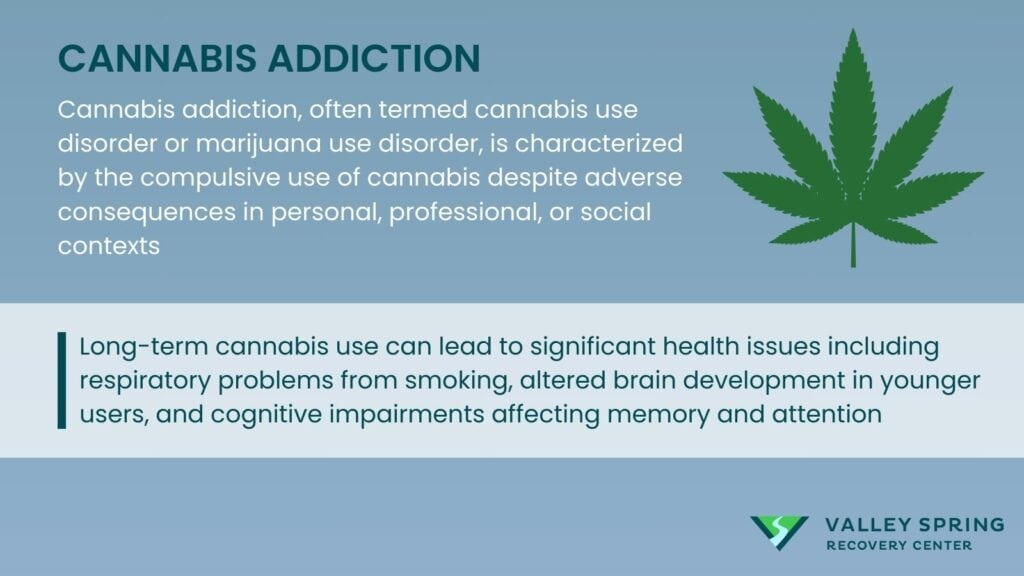
Cannabis addiction, often termed cannabis use disorder or marijuana use disorder, is characterized by the compulsive use of cannabis despite adverse consequences in personal, professional, or social contexts. According to the Diagnostic and Statistical Manual of Mental Disorders (DSM-5), as referenced in a 2022 report by the National Institute on Drug Abuse (NIDA), cannabis addiction is increasingly prevalent due to higher potency strains and greater societal acceptance.
Long-term cannabis use can lead to significant health issues including respiratory problems from smoking, altered brain development in younger users, and cognitive impairments affecting memory and attention. A 2021 study by the American Psychological Association highlights that chronic users might experience mental health problems such as anxiety and depression, and in some cases, the onset of psychosis.
The treatment of marijuana addiction typically involves behavioral therapies, as there are no FDA-approved medications for its treatment. Cognitive-behavioral therapy (CBT), motivational enhancement therapy (MET), and support groups are effective in managing withdrawal symptoms and reducing cannabis use. The Substance Abuse and Mental Health Services Administration (SAMHSA, 2023) underscores the importance of tailored treatment plans that address both psychological and behavioral aspects of addiction.
Hallucinogen Addiction
Hallucinogen addiction encompasses the habitual use of substances like LSD, psilocybin, and MDMA that alter perceptions, thoughts, and emotions. These substances are not typically associated with physical dependency but can create psychological dependence. The National Institute on Drug Abuse (NIDA, 2020) reports that frequent use of hallucinogens can lead to tolerance, requiring users to consume higher doses to achieve the same effects.
The primary concern with hallucinogens is their profound impact on mental health. Users can experience intense, distressing alterations in perception, mood, and thought, known as hallucinogen-persisting perception disorder (HPPD), as per findings in the Journal of Psychopharmacology (2022). Additionally, risky behaviors during hallucinogenic experiences can lead to accidents and injuries.
Treatment for hallucinogen addiction is supportive and psychotherapeutic since there are no specific medications to counteract the effects of hallucinogens. Psychological support, such as psychotherapy and counseling, is critical in helping individuals understand and change their substance use behaviors. Group therapy can also provide peer support and decrease the stigma associated with addiction, as detailed by the American Psychiatric Association’s practice guidelines (2021).
Inhalant Addiction
Inhalant addiction involves the compulsive use of volatile substances that produce chemical vapors, which are inhaled to induce psychoactive effects. This form of addiction is particularly dangerous due to the toxic nature of the substances involved. The National Institute on Drug Abuse (NIDA, 2020) categorizes inhalants as among the most harmful substances, especially to adolescents who make up the majority of users.
Inhalants can cause immediate and severe damage to the heart, kidneys, brain, and liver. The American Medical Association (AMA, 2021) reports that sudden sniffing death syndrome is a significant risk, resulting from heart failure following abuse of inhalants. Chronic exposure can also lead to long-term cognitive deficits and neurological damage.
Treatment strategies for inhalant addiction include detoxification, medical management of withdrawal symptoms, and extensive rehabilitation programs. Because inhalant withdrawal can be particularly severe, close medical supervision is advised during detox. Behavioral interventions, including cognitive-behavioral therapy and family counseling, play essential roles in treatment plans, helping to address the root causes of addiction and promote long-term recovery, as per the guidelines from the American Society of Addiction Medicine (ASAM, 2023).
What Are the Most Commonly Used Drug Addiction Screening Tests?
Drug addiction screening tests are tools used to identify individuals who may be struggling with substance use disorders. These tests help healthcare professionals evaluate the extent of substance use and determine the appropriate level of care. Below are some of the most widely used drug addiction screening tests, along with their definitions, processes, and usages.
DAST-10
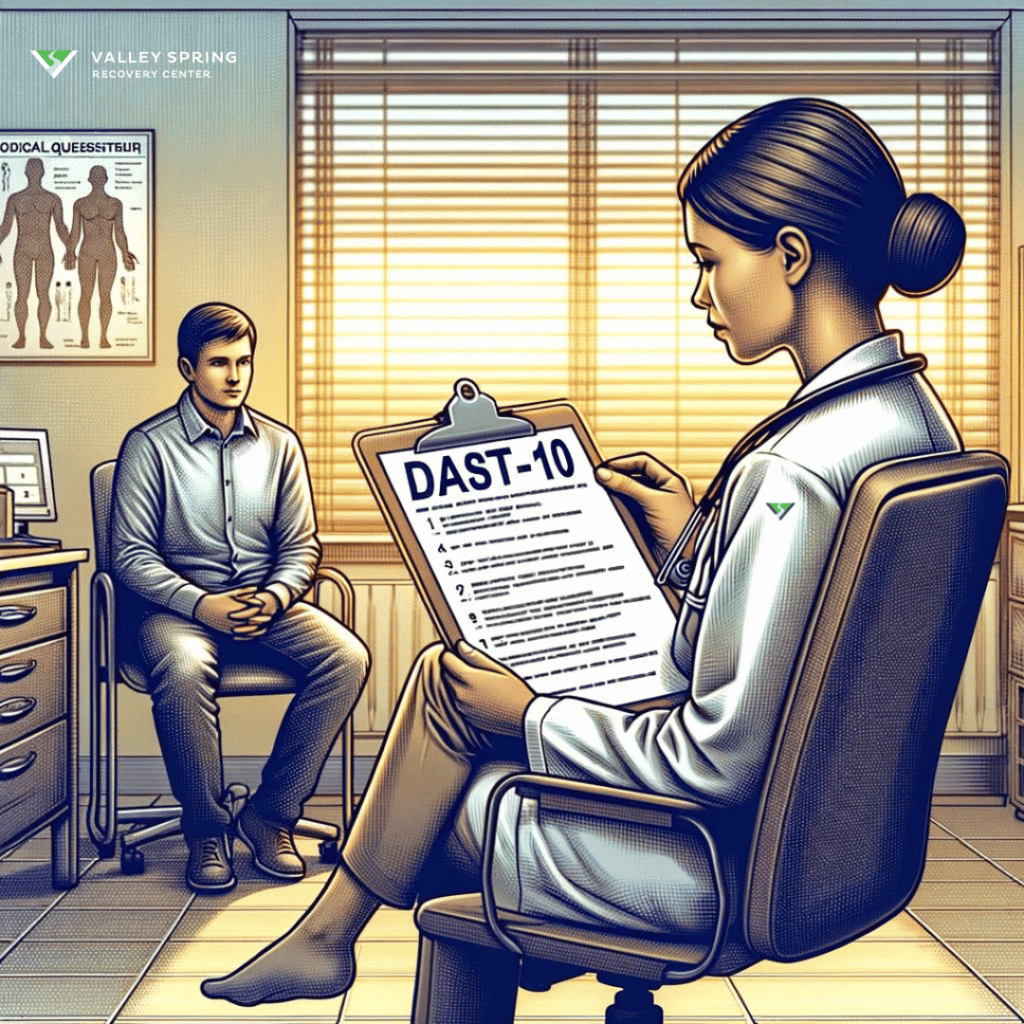
The Drug Abuse Screening Test (DAST-10) is a brief, self-report tool used to screen for drug abuse or dependence in adults.
Patients answer 10 yes-or-no questions related to drug use in the past year. The questions cover various aspects of substance use, including its impact on social, occupational, psychological, and physical functioning.
The Drug Abuse Sreening Test (DAST-10) is widely used in clinical settings to quickly assess the likelihood of drug abuse problems. It helps identify individuals who may benefit from further evaluation or intervention.
CRAFFT
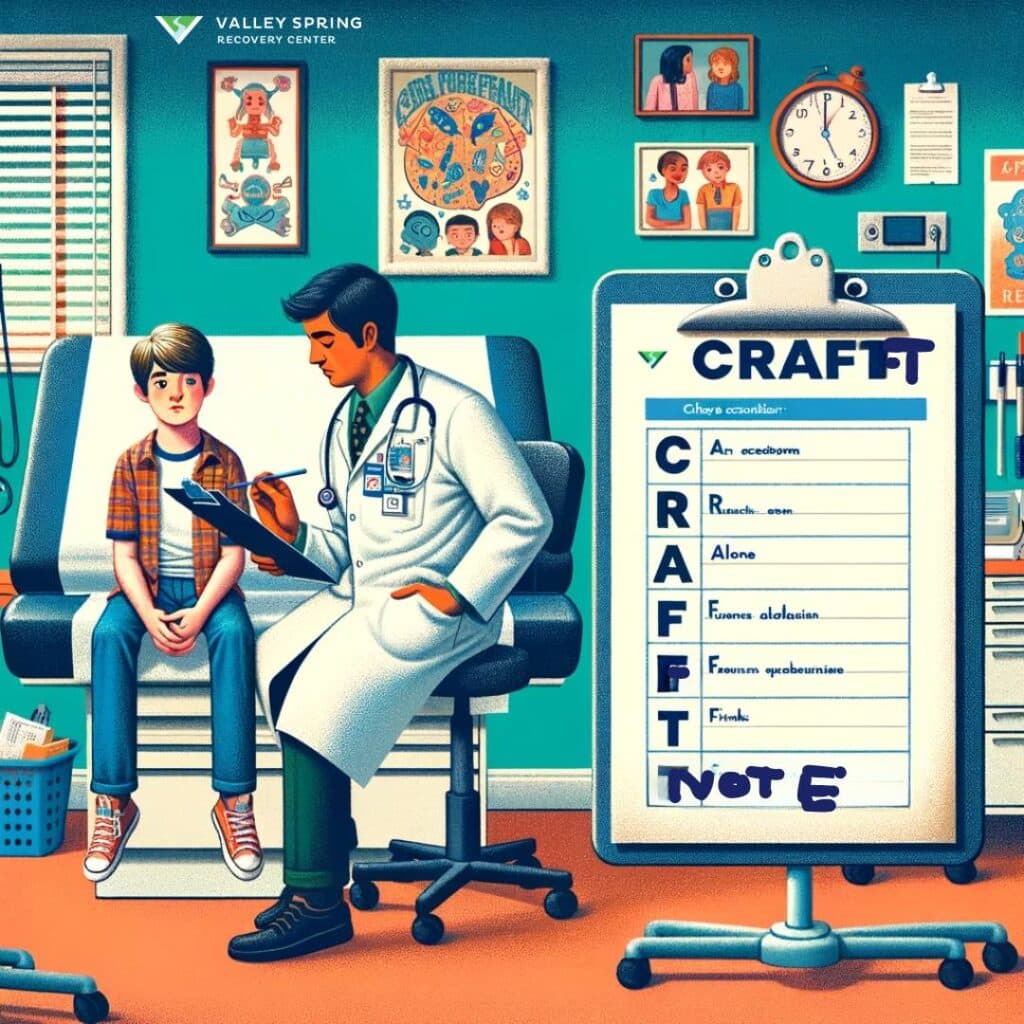
The CRAFFT Screening Test is a brief, behavioral health screening tool for adolescents to assess high-risk alcohol and other drug use disorders.
The test consists of six questions designed to identify risky behaviors and the consequences of substance use. It includes an acronym (Car, Relax, Alone, Forget, Friends, Trouble) to remind clinicians of the questions.
CRAFFT is commonly used in schools, pediatric offices, and primary care settings to detect early signs of substance abuse among adolescents and young adults.
SBIRT
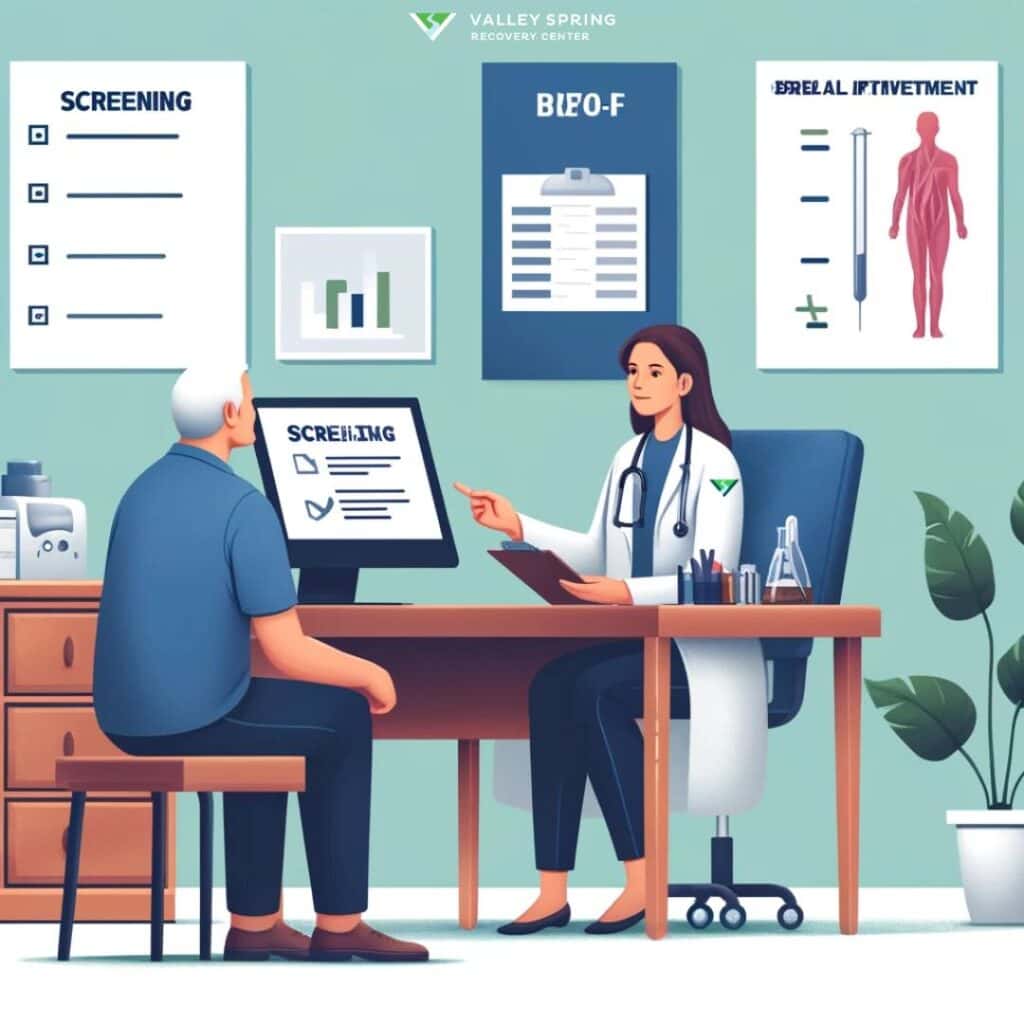
Screening, Brief Intervention, and Referral to Treatment (SBIRT) is a comprehensive, integrated approach to the delivery of early intervention and treatment services for persons with substance use disorders.
SBIRT involves three steps: Screening using standardized tools, Brief Intervention to provide feedback and advice, and Referral to Treatment for those who need specialized care.
SBIRT is implemented in various healthcare settings, including emergency departments, primary care offices, and community clinics, to identify and intervene with patients at risk for substance abuse.
Urine Drug Test (UDT)
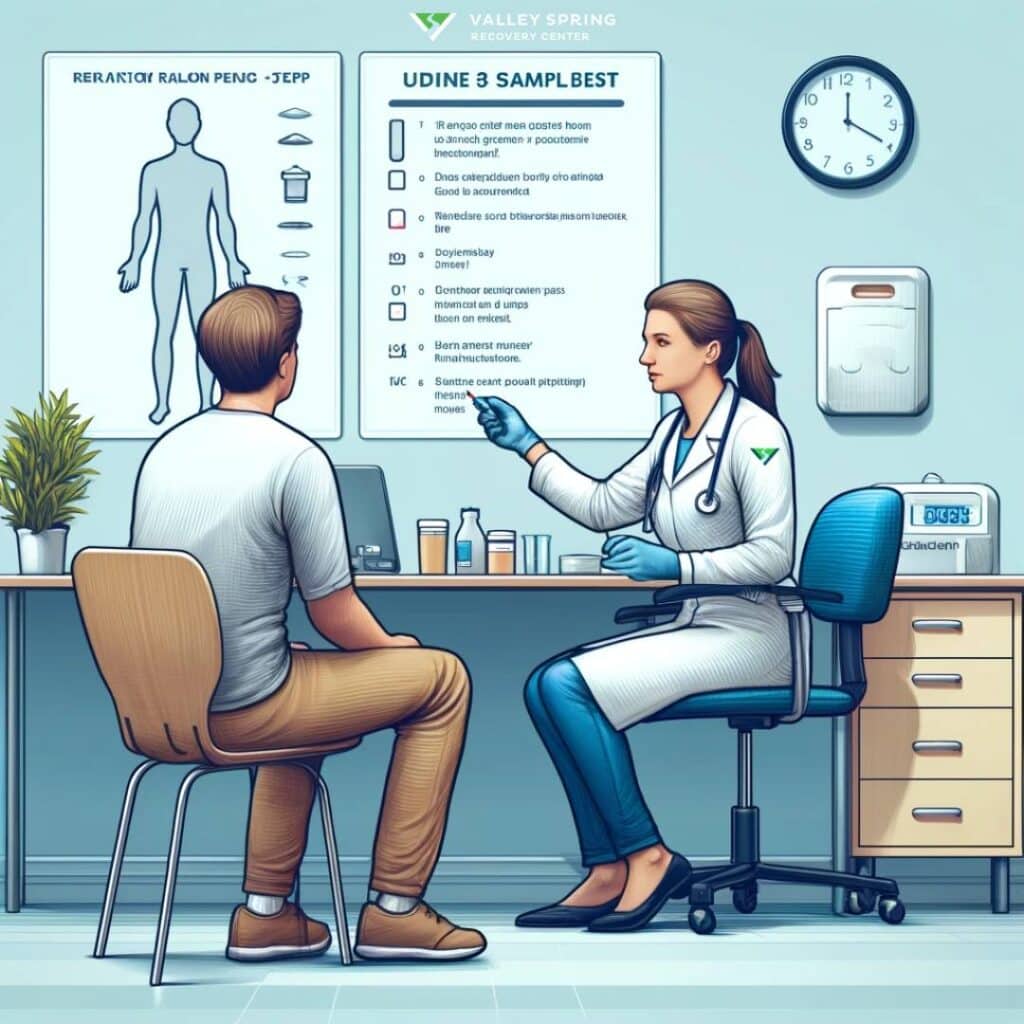
Urine Drug Tests (UDTs) are laboratory analyses of a urine sample to detect the presence of drugs and their metabolites.
A urine sample is collected and analyzed using immunoassay screening followed by confirmatory tests, such as gas chromatography-mass spectrometry (GC-MS) or high-performance liquid chromatography (HPLC).
UDTs are widely used in clinical and forensic settings, including workplace drug testing, addiction treatment monitoring, and criminal justice cases.
NIDA Quick Screen
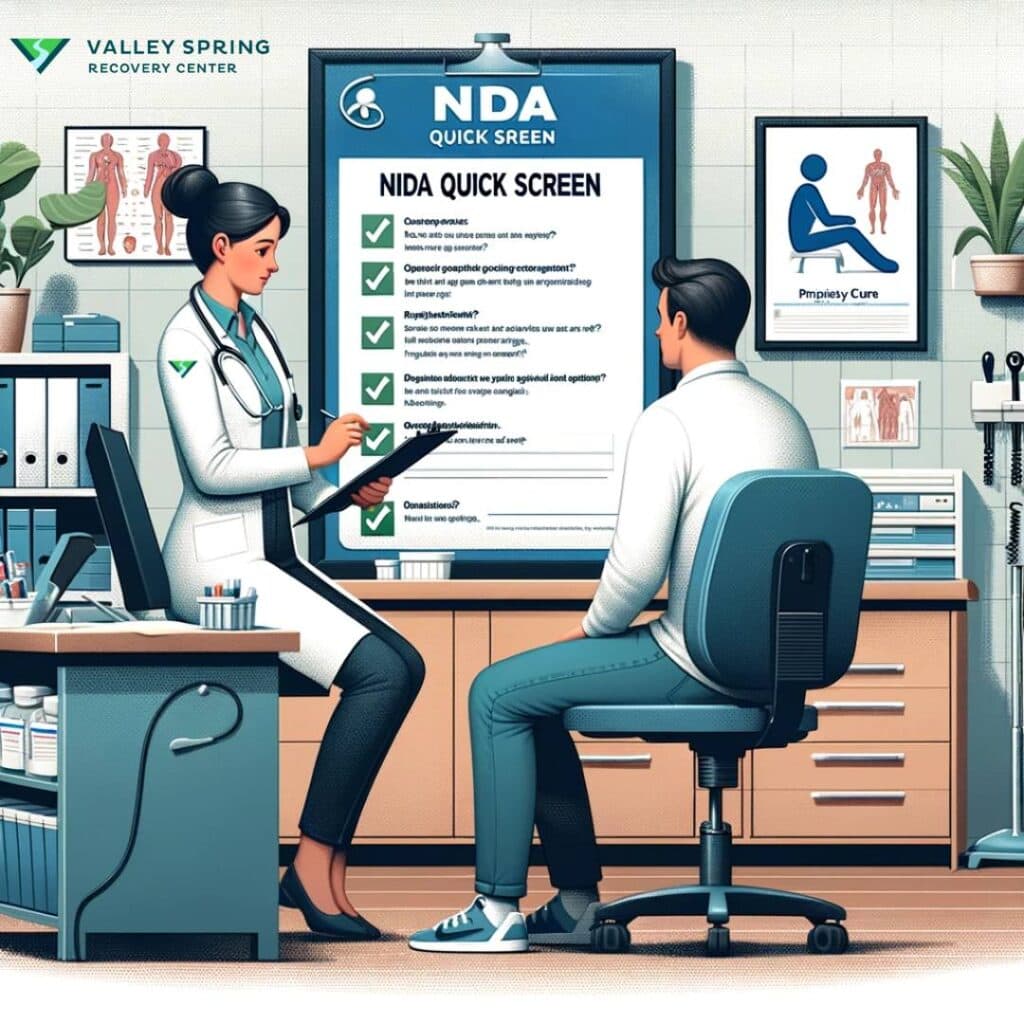
The National Institute on Drug Abuse (NIDA) Quick Screen is a brief screening tool designed to identify substance use disorders in primary care settings.
Patients are asked a series of questions about their use of tobacco, alcohol, illicit drugs, and prescription drugs for non-medical reasons in the past year.
The NIDA Quick Screen is used to quickly identify patients who may need further assessment or intervention for substance use disorders.
CAGE Questionnaire
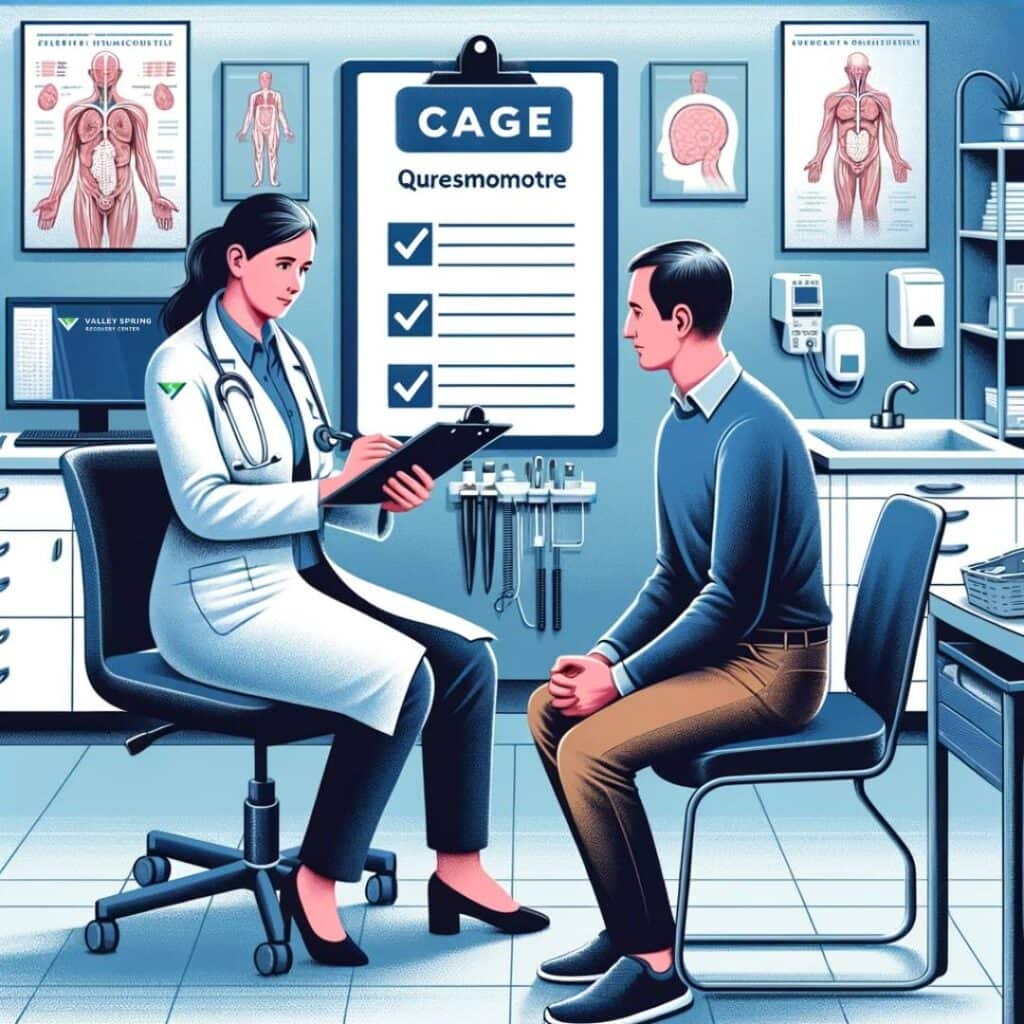
The CAGE Questionnaire is a brief, four-item screening tool used to identify potential alcohol problems.
Patients are asked four questions about their drinking habits: Have you ever felt you should Cut down on your drinking? Have people Annoyed you by criticizing your drinking? Have you ever felt Guilty about drinking? Have you ever had a drink first thing in the morning (an Eye-opener)?
The CAGE Questionnaire is commonly used in primary care and mental health settings to quickly screen for alcohol use disorders.
MAST
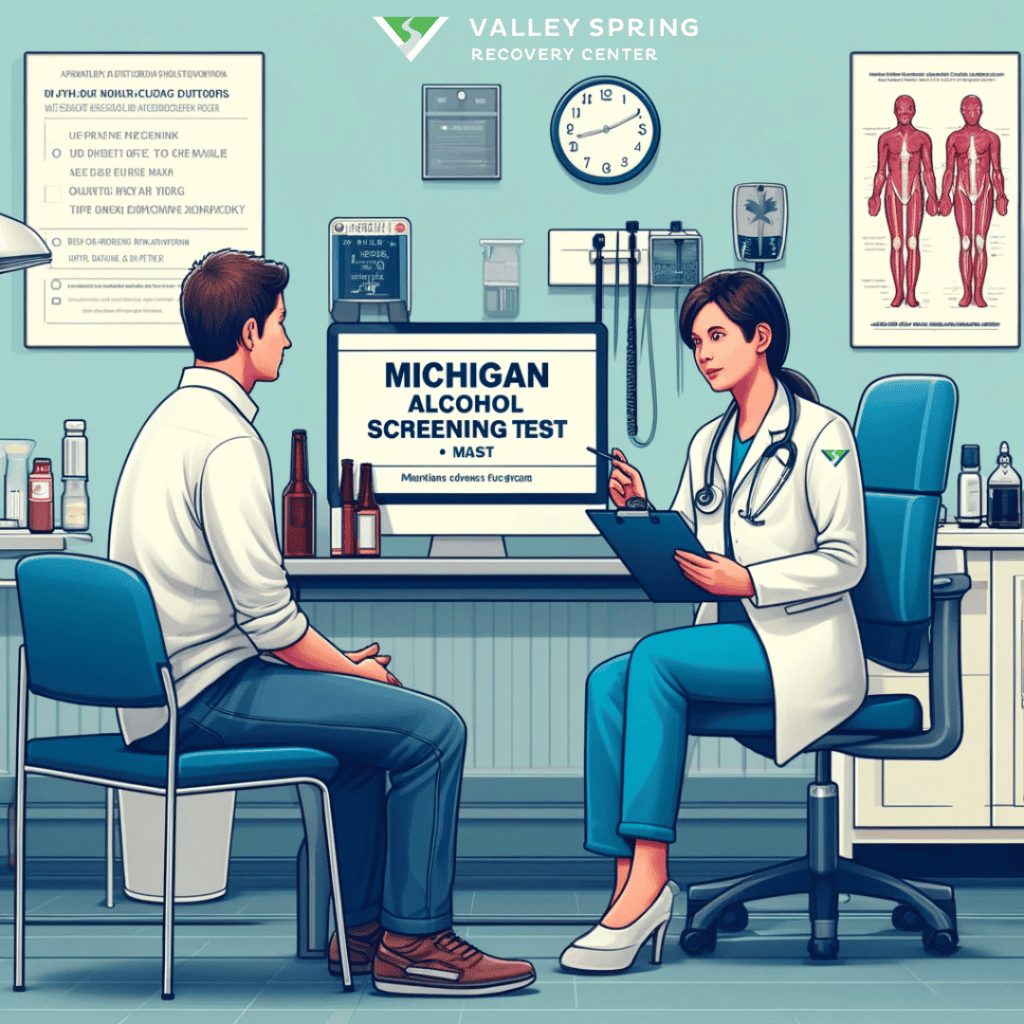
The Michigan Alcohol Screening Test (MAST) is one of the oldest and most widely used tools for detecting alcohol dependency.
The MAST consists of 22 questions about the patient’s drinking behavior and its impact on their life. Responses are scored to determine the likelihood of an alcohol use disorder.
The MAST is used in both clinical and research settings to identify individuals with alcohol dependency and to assess the severity of their condition.
What Are The Types Of Drug Addiction Treatment?
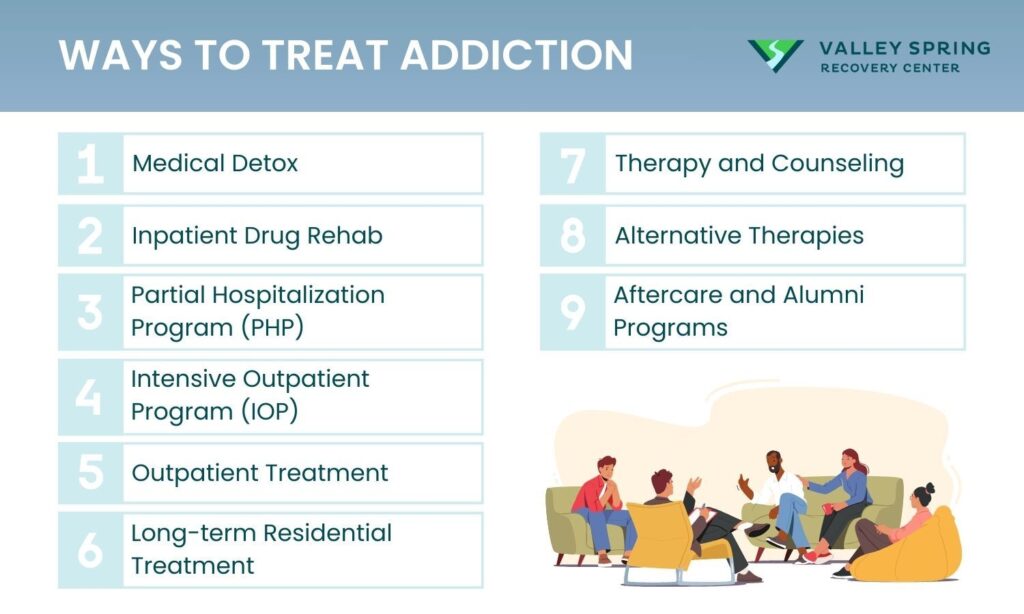
Drug addiction treatment encompasses a range of approaches designed to help individuals stop using drugs, and address mental, physical, and behavioral symptoms to achieve lasting recovery and sobriety. According to the Substance Abuse and Mental Health Services Administration (SAMHSA), effective treatment addresses multiple needs of the individual, not just their drug use. Below are the common types of drug addiction treatment options offered by drug and alcohol rehab centers, along with their definitions, advantages, disadvantages, and typical usage durations, enhanced with the ASAM Criteria guidelines on levels of care.
1. Medical Detox
Medical detox is the initial phase of addiction treatment where substances are safely removed from the body under medical supervision. This process ensures physical stabilization, manages severe withdrawal symptoms, and prepares individuals for further therapeutic interventions. The importance of medical detox cannot be overstated, as withdrawal symptoms can be severe and even life-threatening. The ASAM Criteria defines this level of treatment intensity as Level 4: Medically Managed Intensive Inpatient Services, which provides 24-hour medically directed evaluation and care.
The advantages of medical detox include physical stabilization, managing severe withdrawal symptoms, and preparing individuals for further treatment.
The disadvantages of medical detox are that it does not address psychological aspects of addiction and needs to be followed by other treatments.
Medical detox typically lasts from a few days to two weeks, depending on the substance being abused and co-morbidities.
2. Inpatient Rehab
Inpatient rehab involves residential treatment where patients stay at a facility and receive intensive care. This type of treatment provides structured support, a sense of community, and comprehensive care that includes therapy, medical observation, detoxification, and holistic treatments. The controlled environment allows for constant monitoring and immediate intervention, which is beneficial for physical, mental, and emotional recovery. The ASAM Criteria includes Level 3.7: Medically Monitored Intensive Inpatient Services and Level 3.5: Clinically Managed High-Intensity Residential Services.
The advantages of inpatient rehab are the comprehensive and continuous care provided, which can be crucial for individuals with severe addictions.
The disadvantages of inpatient rehab include its cost and the requirement for patients to take time away from home, work, or school.
Inpatient rehab generally lasts from 30 to 90 days, but the duration can vary based on the individual’s needs and progress.
3. Partial Hospitalization Program (PHP)
A Partial Hospitalization Program (PHP), also known as “day treatment,” offers high-level medical and therapeutic care while allowing patients to live at home. PHP is an intensive form of outpatient care that provides a balance between treatment and daily life, making it ideal for individuals who need significant support but have a stable home environment. The ASAM Criteria defines this as Level 2.5: Partial Hospitalization Services, which provides 20 or more hours of service per week.
The advantages of PHP include receiving intensive care without overnight stays, which allows for a balance between treatment and daily life.
The disadvantages of PHP include the requirement for a strong support system at home, making it unsuitable for individuals with unstable living conditions.
PHP typically involves several hours of treatment per day, 3-5 days a week, for a few weeks to months.
4. Outpatient Treatment
Outpatient treatment provides therapy and counseling services without requiring patients to stay overnight at a facility. This flexible option is suitable for individuals who have a strong support system at home and need to continue with their daily responsibilities while receiving treatment. The ASAM Criteria defines this as Level 1.0: Outpatient Services, which provides less than 9 hours of service per week, and Level 1.5: Outpatient Therapy.
The advantages of outpatient treatment include a flexible schedule that accommodates work, school, and family commitments.
The disadvantages of outpatient treatment include its lower intensity, which may not be suitable for severe addictions.
Outpatient treatment can range from a few months to a year, with varying frequencies of therapy sessions.
5. Telehealth
Telehealth is a delivery method for IOP and Outpatient treatment that takes place through online therapy sessions and consultations with healthcare providers. This approach makes treatment accessible from any location, which is especially beneficial for those with mobility issues or who live in remote areas.
The advantages of telehealth include its accessibility from any location, making it convenient for individuals with mobility issues or those residing in remote areas.
The disadvantages of telehealth include the lack of physical presence, which can limit effectiveness for some individuals.
The duration of telehealth treatment for addiction varies based on individual needs and program structure.
6. Intensive Outpatient Program (IOP)
An Intensive Outpatient Program (IOP) provides a higher level of care than standard outpatient programs, with more frequent and longer therapy sessions. IOP is designed for individuals who need significant support but do not require 24/7 supervision. The ASAM Criteria defines this as Level 2.1: Intensive Outpatient Services, which provides 9 or more hours of service per week, and Level 2.7: Medically Managed Intensive Outpatient Services.
The advantages of IOP include intensive support while allowing patients to maintain daily responsibilities.
The disadvantages of IOP include the requirement for a high level of commitment and time management from the patient.
IOP drug rehab involves 9 or more hours of service per week through multiple sessions, lasting several hours each, over a period of weeks to months.
7. Therapy
Therapy in addiction treatment includes individual, group, and family therapy sessions. These sessions address the psychological aspects of addiction, help develop coping skills, and foster support networks.
The advantages of therapy include addressing underlying issues contributing to addiction and providing tools for long-term recovery.
The disadvantages of therapy include the slow progress and need for active participation and honesty, which can be challenging for some individuals.
Therapy is ongoing and often continues for several months to years as part of aftercare, depending on the individual’s needs and progress.
8. Holistic Treatment
Holistic treatment incorporates non-traditional therapies such as acupuncture, yoga, meditation, and art therapy. These treatments aim to treat the whole person, promoting overall well-being and stress reduction.
The advantages of holistic treatment include its comprehensive approach to health, addressing physical, mental, and emotional well-being.
The disadvantages of holistic treatment include the lack of scientific evidence for some holistic methods and potential issues with insurance coverage.
Holistic treatments can be integrated into other treatment programs or used as supplementary treatments, with the duration varying based on individual needs.
9. Aftercare
Aftercare programs offer ongoing support and resources to maintain sobriety post-treatment. These programs are crucial for reducing the risk of relapse, providing a support network, and continuing skill-building for long-term recovery.
The advantages of aftercare include providing ongoing support, which helps individuals stay committed to their recovery.
The disadvantages of aftercare include the need for continuous commitment, which can be challenging to maintain over time.
Aftercare typically involves regular meetings and support sessions, potentially lasting for several years.
10. Recovery Residences
Recovery residences, often referred to as sober living or transitional living homes provide safe and healthy living environments that promote recovery from alcohol and other drug use. These are not formal treatment programs but offer peer support and accountability in a sober living environment.
The advantages of recovery residences include providing a supportive community, fostering accountability, and helping individuals transition back into daily life.
The disadvantages of recovery residences include not being a substitute for formal treatment programs and the potential requirement for residents to follow specific rules and guidelines.
The duration of stay in recovery residences can vary from a few months to several years, depending on individual needs and progress.
How Does Medication Play a Role in Treating Addiction and What is Medication-Assisted Treatment (MAT)?
Medications play a critical role in the treatment of drug addiction, primarily used to manage withdrawal symptoms, prevent relapse, and address co-occurring mental health conditions. Medication-Assisted Treatment (MAT) combines the use of FDA-approved medications with counseling and behavioral therapies. This approach aims to treat the whole patient, addressing both the physical and psychological aspects of addiction.
MAT helps normalize brain chemistry, blocks the euphoric effects of alcohol and opioids, alleviates physiological cravings, and stabilizes body functions. It is particularly effective for opioid use disorder, alcohol use disorder, and smoking cessation.
Medications Used in MAT:
- Opioid Addiction:
- Methadone: Reduces cravings and withdrawal symptoms, taken daily under medical supervision.
- Buprenorphine: Partial opioid agonist that reduces cravings and withdrawal symptoms, with a lower risk of misuse.
- Naltrexone: Blocks the euphoric and sedative effects of opioids, preventing relapse.
- Alcohol Addiction:
- Disulfiram: Causes unpleasant reactions when alcohol is consumed, deterring individuals from drinking.
- Acamprosate: Helps maintain abstinence by reducing the desire to drink.
- Naltrexone: Reduces alcohol cravings and the pleasurable effects of drinking.
- Nicotine Addiction:
- Nicotine Replacement Therapy (NRT): Patches, gum, and lozenges that provide a controlled dose of nicotine to ease withdrawal symptoms.
- Bupropion: A non-nicotine medication that helps reduce cravings and withdrawal symptoms.
- Varenicline: Reduces cravings and withdrawal symptoms by targeting nicotine receptors in the brain.
Benefits of MAT
Biochemical Support: MAT provides essential biochemical support to help patients stabilize physically and mentally during the early phases of recovery. By managing withdrawal symptoms and cravings, MAT enables individuals to focus on their recovery process without the constant distraction of physical discomfort.
Relapse Prevention: Medications used in MAT, such as naltrexone for opioid and alcohol addiction, block the euphoric effects of these substances. This reduces the incentive to relapse, as the individual no longer experiences the same “high” from substance use.
Treatment of Co-occurring Conditions: Many individuals with substance use disorders also suffer from co-occurring mental health conditions such as depression, anxiety, or PTSD. Medications used in MAT can help address these conditions, providing a more holistic approach to treatment.
Improved Outcomes: Research shows that MAT increases retention in treatment programs, decreases illicit opioid use, reduces criminal activity, and improves patients’ ability to gain and maintain employment. By addressing both the physical and psychological aspects of addiction, MAT contributes significantly to long-term recovery and overall well-being.
Medication-Assisted Treatment (MAT) plays a vital role in the comprehensive management of addiction. By integrating medications with counseling and behavioral therapies, MAT addresses the complex interplay of physical dependence and psychological issues associated with substance use disorders. This approach not only helps stabilize individuals during the critical early stages of recovery but also supports long-term success by reducing the risk of relapse and improving overall mental health.
What Are The Addiction Statistics?
Addiction is a pervasive and multifaceted issue that goes beyond personal lives, extending its reach into entire communities and industries. As explored in our previous article on the effects of drugs and alcohol in the workplace, nearly 8.7 percent of full-time workers aged 18 to 64 reported having a substance use disorder (SUD) in the past year. This prevalence varies across industries, with construction witnessing as high as 16.5%, compared to 4.3% in education services. Age and gender also play significant roles in SUD rates, with younger workers and males generally experiencing higher rates. The economic impact of substance abuse in the workplace is tangible, leading to decreased productivity, increased absenteeism, and elevated healthcare costs. According to the White House drug addiction statistics, addiction is responsible for $120 billion in lost productivity and $11 billion in healthcare costs alone. Health and Human Services states he annual economic impact of substance misuse is estimated to be $249 billion for alcohol misuse and $193 billion for illicit drug use.
What Are The Risks Of Drug Overdose as a Result of Drug Abuse?
The risks of overdosing on drugs are both significant and devastating, highlighted by escalating trends and sobering statistics that underscore the persistent challenge of drug overdose in the United States. According to the National Vital Statistics System, drug overdose deaths continue to rise, with a 14% increase from 2020 to 2021, resulting in 106,699 fatalities in the latter year. The pervasive impact of opioids, especially synthetic opioids other than methadone, remains the primary catalyst for these deaths, accounting for approximately 75.4% of all drug overdose fatalities in 2021.
Key Points on Drug Overdose Risks:
- Opioid Epidemic: In 2021, opioids were involved in 80,411 deaths, with synthetic opioids being the predominant factor. This category of drugs significantly influences the high rates of overdose deaths, reflecting their potent nature and widespread misuse.
- Increasing Rates with Psychostimulants: There is also an alarming increase in overdose deaths involving psychostimulants such as methamphetamine, often compounded by the concurrent use of synthetic opioids.
- Impact of the COVID-19 Pandemic: The pandemic exacerbated the overdose crisis, contributing to a 30% spike in drug overdose deaths from 2019 to 2020. Factors such as increased stress, anxiety, and isolation have intensified substance use and the consequent risk of overdose.
- Preventability: A notable 92% of drug overdose deaths could potentially be prevented through measures like timely administration of naloxone, improved prescription practices, and vigilant monitoring of drug use.
- Demographic Vulnerabilities: The data reveals that middle-aged men are disproportionately affected, being more than twice as likely to die from a drug overdose compared to women. Among women, the highest number of overdose deaths occurs in the 44 to 54-year age group.
- Regional Variations: There have been significant regional fluctuations in overdose death rates, with marked increases in states like Washington, Oregon, Alaska, and Nevada, and decreases in North Carolina, Wisconsin, Florida, and Georgia between 2022 and 2023.
These drug overdose statistics underscore the critical need for comprehensive strategies that include both prevention and intervention measures tailored to address the multifaceted nature of drug overdose. The ongoing efforts by organizations such as the CDC and the National Institute of Drug Abuse aim to curb these rising trends through public health initiatives and research focused on reducing the impact of this severe public health issue.
What Does Drug Addiction Do To The Brain?
Drug addiction exerts a multifaceted impact on the brain’s neural architecture, fundamentally altering its reward, cognitive, and emotional circuits. Initially, substances with addictive potential hijack the brain’s reward system, flooding it with dopamine—a neurotransmitter linked to pleasure and reinforcement. It’s important to understand the science of drug addiction and the brain because the dopamine surge from ingesting drugs not only induces an intense feeling of euphoria but also reinforces the drug-taking behavior, setting the stage for a vicious cycle of addiction. Over time, the brain adapts to these dopamine spikes by reducing the responsiveness of the neural cells in the reward circuit, a phenomenon known as ‘tolerance.’ This adaptation diminishes the individual’s ability to derive pleasure from other life-affirming activities, such as social interaction, eating, or sexual activity, thereby narrowing their sources of pleasure to the drug itself. Moreover, long-term drug use extends its damaging effects to other neural circuits, impairing cognitive functions like learning, judgment, and decision-making, while also affecting emotional regulation and stress response which further differentiates a drug-addicted brain vs normal brain. Despite being cognizant of these adverse outcomes, the individual often finds themselves ensnared in a self-perpetuating cycle of substance abuse, epitomizing the paradoxical and self-destructive nature of addiction.
How do drugs interact with the brain to cause addiction?
Drugs target the brain’s reward system, flooding it with dopamine. This leads to repeated use, eventually causing changes in neural circuits that result in addiction. The brain’s reward center becomes used to receiving the dopamine spike that occurs when drugs are received into the system, making it harder and harder to stop, resulting in increased dependence.
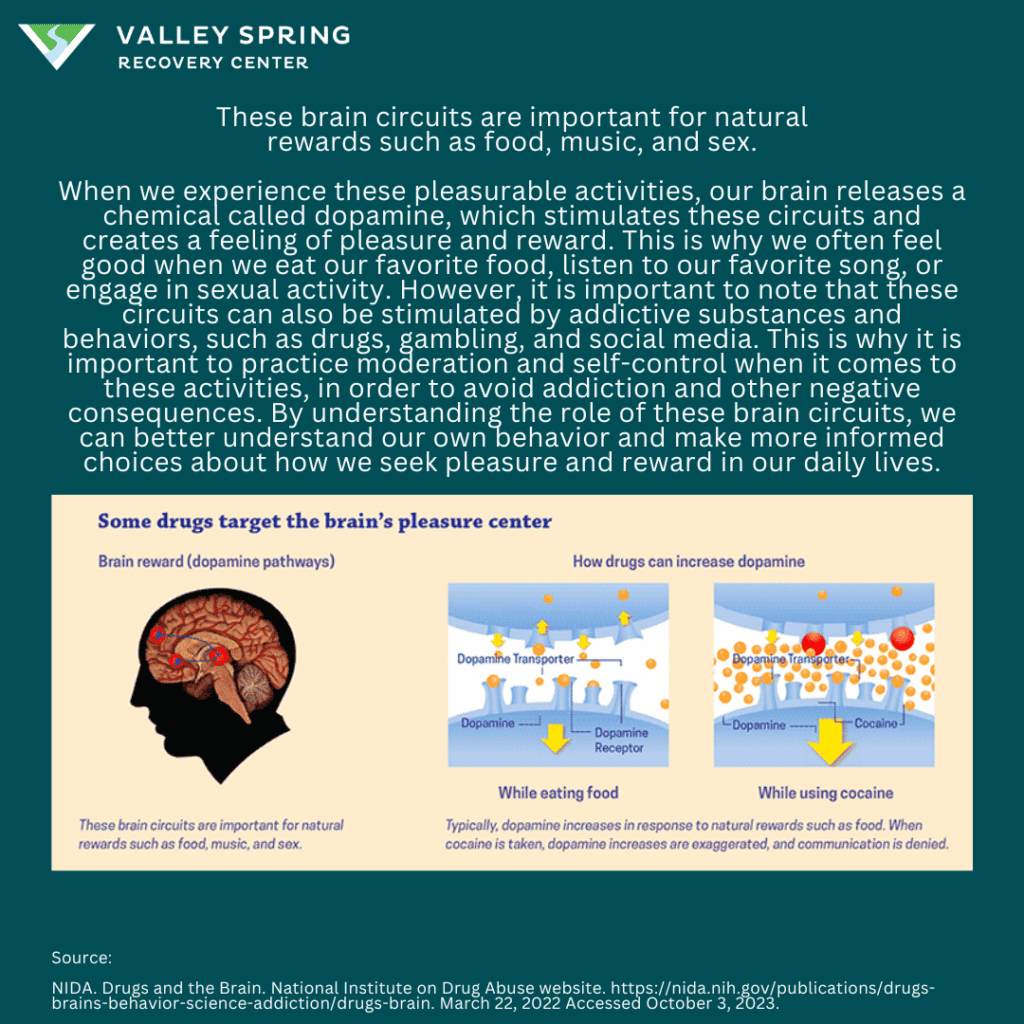
frequently asked questions (FAQs) about Addiction
What is the Relationship Between Addiction and Mental Health?
The relationship between addiction and mental health is intricate and multifaceted, often leading to a complex interplay between the two. Here’s an in-depth look at this relationship:
-
Co-Occurrence: Mental health disorders and addiction often co-occur. This means that individuals struggling with addiction might also have one or more mental health conditions, such as depression, anxiety, or bipolar disorder, and vice versa.
-
Shared Risk Factors: Both mental health and addiction have shared genetic, environmental, and biological risk factors. For example, genetic predisposition, trauma, and chronic stress can increase the likelihood of both mental illness and addiction.
-
Cause and Effect: In some cases, mental health disorders might contribute to addiction. A person suffering from anxiety or depression has a higher liklihood of turning to drugs or alcohol as a form of self-medication. Conversely, chronic substance abuse can lead to mental health issues, as the effects of drugs and alcohol can alter brain chemistry and exacerbate underlying mental health symptoms.
-
Impact on Treatment: The interconnection between mental health and addiction necessitates an integrated approach to treatment. Treating one condition without addressing the other can hinder recovery. Dual-diagnosis treatment centers provide comprehensive care that addresses both mental health and substance abuse disorders simultaneously.
-
Recovery Challenges: The overlapping nature of mental health and addiction can make recovery more challenging. Symptoms of mental health disorders might trigger cravings and relapse, while withdrawal from substances might worsen mental health symptoms. Ongoing support and specialized care tailored to the individual’s specific needs are crucial.
-
Prevention and Early Intervention: Understanding the link between mental health and addiction emphasizes the importance of early intervention and prevention. Addressing mental health symptoms early, providing support, education, and therapy, can reduce the risk of developing an addiction.
-
Social and Societal Factors: Stigma surrounding both mental health and addiction can create barriers to seeking help. Encouraging open dialogue, reducing stigma, and providing accessible services are essential for supporting those affected by these interconnected issues.
The relationship between addiction and mental health is complex, characterized by a two-way influence where one condition can exacerbate the other. Recognizing and addressing this relationship is vital for effective treatment, prevention, and ongoing support. Understanding the interplay between addiction and mental health underscores the need for holistic approaches that consider the entire spectrum of an individual’s well-being.
How Does Addiction Impact the Workplace?
Substance abuse in the workplace can lead to increased absenteeism, decreased productivity, and higher healthcare costs, varying across industries. Laws concerning substance abuse in the workplace vary by jurisdiction and include implementing drug-free workplace policies, conducting drug testing, and providing Employee Assistance Programs (EAPs). Employers are tasked with balancing employee privacy rights with maintaining a safe and productive work environment, and compliance with applicable laws is crucial.
How Do Family Dynamics Influence Addiction?
Family dynamics and relationships can significantly influence an individual’s susceptibility to addiction. Dysfunctional family patterns, such as neglect, abuse, or lack of communication, increase the risk. In contrast, strong family support can be a powerful aid in recovery. Family therapy is often incorporated into treatment plans, allowing family members to understand addiction better and learn how to support their loved one effectively.
What is the Role of Support Groups in Addiction Recovery?
Support groups like Alcoholics Anonymous (AA) or Narcotics Anonymous (NA) provide a sense of community, empathy, encouragement, and accountability for those in recovery. They create a non-judgmental space where individuals can share experiences and support one another. These support systems can be essential in maintaining sobriety and provide ongoing care after formal treatment has ended.
How Does Addiction Affect Pregnancy?
Addiction during pregnancy can have serious health effects on both the mother and the unborn child, including preterm birth, low birth weight, developmental problems, and neonatal abstinence syndrome. Treatment for pregnant women with addiction often requires specialized care, focusing on both the mother’s health and the child’s development, including counseling, medical supervision, and carefully managed detoxification if necessary.
What Are the Cultural and Societal Influences on Addiction?
Cultural norms, societal pressures, and stigma can shape individual and community attitudes towards addiction. These influences affect prevalence, perception, treatment, and recovery. Understanding and addressing these factors requires a holistic approach to addiction, recognizing its complexity, and considering cultural competence and sensitivity in treatment and prevention efforts.
What Are the Latest Innovations in Addiction Treatment?
The field of addiction treatment continues to evolve with innovations like personalized therapy plans based on genetic and behavioral analysis, medication-assisted treatment that reduces cravings, telemedicine for remote access to care, and holistic approaches that integrate physical, mental, and spiritual wellness. These innovations aim to provide more effective and accessible care tailored to the unique needs of each individual.
Who is Affected by Drug Addiction?
Drug addiction is a pervasive issue that impacts not only the individual struggling with the addiction but also a wide range of people connected to them. It’s a misconception that addiction solely affects the person using the substances; its repercussions are far-reaching:
-
Family Members:
- Relatives of an addict often face emotional distress, financial strain, and social stigma. The impact on children can be particularly profound, affecting their emotional and sometimes physical well-being.
-
Friends and Social Networks:
- The social circles of an addict experience strained relationships, trust issues, and emotional fatigue due to the erratic and sometimes harmful behaviors associated with addiction.
-
Workplace and Professional Relationships:
- Addiction can lead to decreased productivity, absenteeism, and strained professional relationships, impacting businesses and colleagues.
-
Healthcare System:
- The burden on healthcare services increases due to the need for medical treatment for health issues related to addiction.
-
Community and Society at Large:
- Communities deal with higher rates of crime, increased healthcare costs, and other social issues stemming from the effects of widespread substance abuse.
Understanding that drug addiction is a multifaceted issue affecting various aspects of society can lead to more empathetic and comprehensive approaches to treatment and prevention.
Is Addiction a Disease or a Choice?
Addiction is a chronic relapsing disease of the brain. The subject is widely debated with many dissenting opinions, but according to doctors and medical research, drug addiction is a disease and not a choice. Drug addiction It’s characterized by compulsive substance use despite harmful consequences. While the initial decision to use a substance may be voluntary, repeated use can lead to changes in the brain that impair self-control and hamper the ability to resist cravings, making it a medical condition rather than a mere choice.
Not all behavioral addictions are classified as a disease though. The Diagnostic and Statistical Manual of Mental Disorders (DSM) recognized behavioral addictions for the first time in DSM-5 with gambling disorder, formerly pathological gambling, as the only non-substance-related disorder classified under the chapter of “Substance-Related and Addictive Disorders”.
What are the most common drug addictions?
The most common drug addictions in the United States vary, with alcohol, nicotine, and marijuana topping the list due to their widespread legal status and social acceptance. Alcohol is particularly notable, with about 28.3 million people aged 12 or older reporting struggles with an alcohol use disorder as of 2020. Nicotine follows, with approximately 23.6 million Americans facing addiction, largely due to the legal status and accessibility of tobacco products. Marijuana also features prominently, with around 14.2 million Americans having a marijuana use disorder, a situation exacerbated by increasing legalization and social acceptability of the drug.
What Are The Most Expensive Illegal Drugs?
The costs of the most expensive illegal drugs vary significantly, reflecting their potency and the risks associated with their use. Cocaine is one of the most expensive, costing between $80 to $100 per gram, reflecting its high demand and the dangers involved in its trade and use. Heroin follows, with a cost of about $15 to $20 per dose, attributed to its high risk of addiction and overdose. Methamphetamine varies widely in price, from $3 to $500 per dose, depending on its form and purity.
Where Is Addiction Treated?
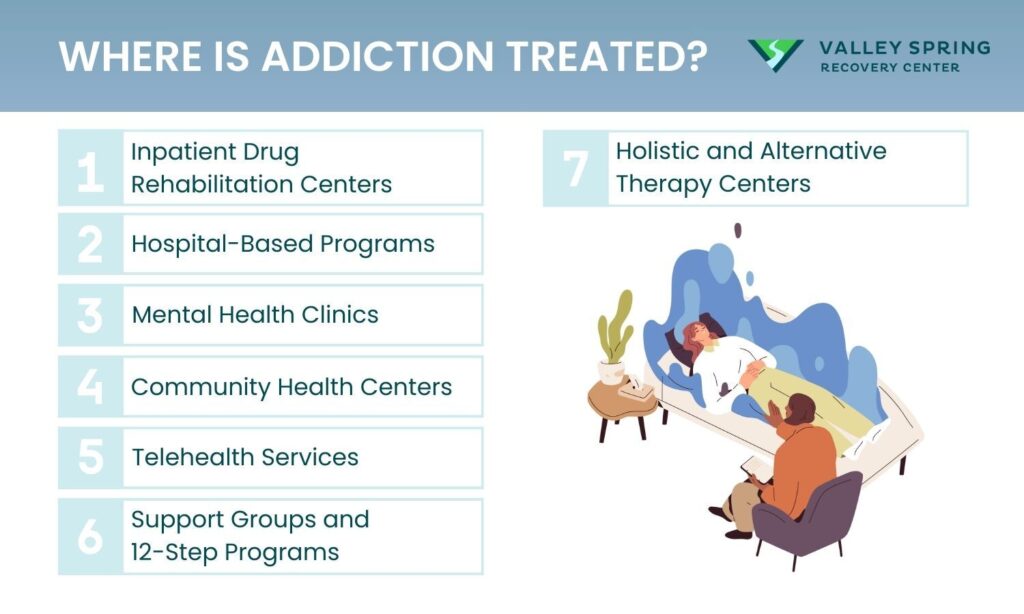
Addiction treatment is a multi-faceted endeavor that can take place in various settings, each offering a unique approach to recovery. The choice of treatment setting often depends on the severity of the addiction, the substance involved, and the individual’s specific needs. Different types of treatment providers are collectively referred to as drug rehab centers. Here is a comprehensive overview of the primary locations where addiction is treated:
Inpatient Drug Rehabilitation Centers: The most conventional setting for addiction treatment is a drug rehabilitation center. These facilities offer a structured environment that provides both medical and psychological support. They often include detoxification services, individual and group therapy, medication-assisted treatment, and aftercare planning. Rehab centers that are residential or inpatient mean the individuals reside at the facility, whereas in outpatient programs allow patients to continue living offsite.
Hospital-Based Programs: Some hospitals offer specialized addiction treatment programs, particularly for cases requiring medical detoxification or co-occurring mental health conditions. These programs provide a higher level of medical supervision compared to standard rehab centers.
Mental Health Clinics: For individuals dealing with both addiction and mental health issues, specialized mental health clinics can offer dual diagnosis treatment. These facilities provide integrated care that addresses both conditions simultaneously, improving the chances of long-term recovery.
Community Health Centers: These centers offer outpatient addiction treatment services, often at a lower cost. Community health centers provide medication-assisted treatment, counseling, and referral services for more intensive treatment if needed.
Telehealth Services: With the advent of technology, online platforms now offer telehealth services for addiction treatment. These services are particularly useful for those who cannot access traditional treatment centers due to geographical or financial constraints.
Support Groups and 12-Step Programs: Organizations like Alcoholics Anonymous (AA) and Narcotics Anonymous (NA) offer peer-led support groups. While not a substitute for professional treatment, many find these groups beneficial as a supplementary form of support.
Holistic and Alternative Therapy Centers: Some individuals opt for holistic treatments like acupuncture, yoga, and herbal medicine as adjunct therapies. While the efficacy of these methods is still under study, some find them beneficial in managing withdrawal symptoms and cravings.
Sources
- Conti, A. A., & Baldacchino, A. (2023). Early-onset smoking theory of compulsivity development: a neurocognitive model for the development of compulsive tobacco smoking.
- Abdullahi, A. A., Abidemi, O. R., & Ntozini, A. (2023). Drug addiction and marital conflicts: Exploring the experiences of drug-addicted wives in Abuja, Nigeria.
- Sarker, A., Raju, F. R., Sultana, M. P., Milon, M. M. M., & Akter, S. (2023). Exploration of drug addiction prevalence among young generation of Pabna district, Bangladesh.
- Wirogioto, A. J. (2022). Cigarette Addiction as The Gateway to Drug Addiction.
Dr. Michael Olla
All author postsShare This Post

